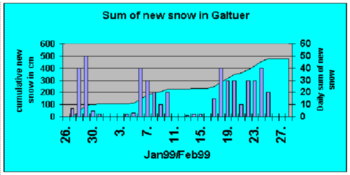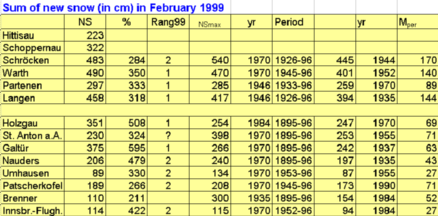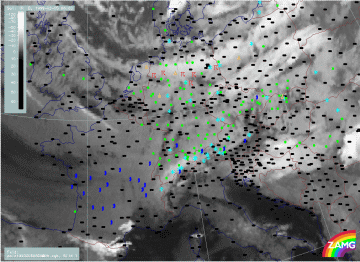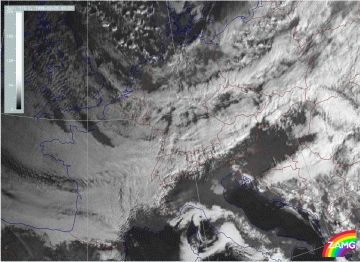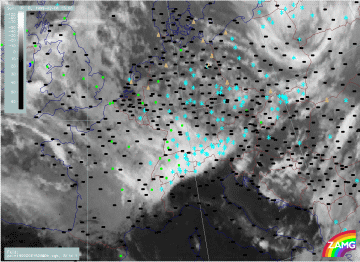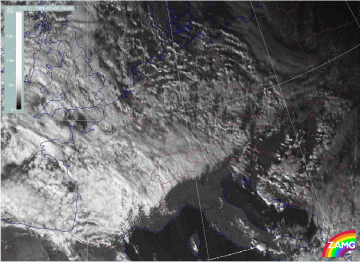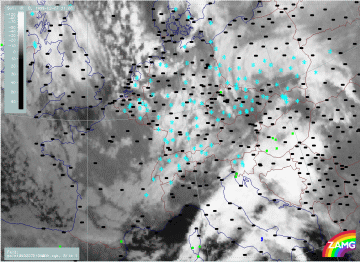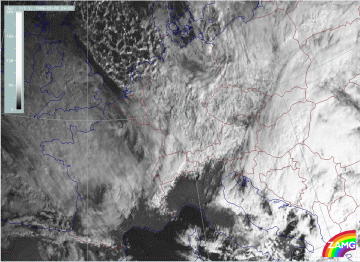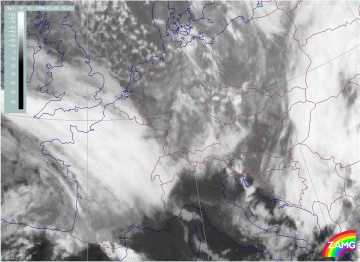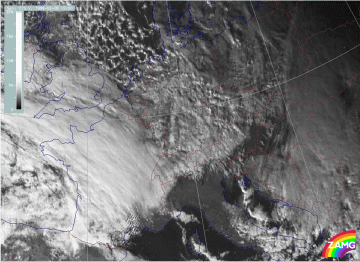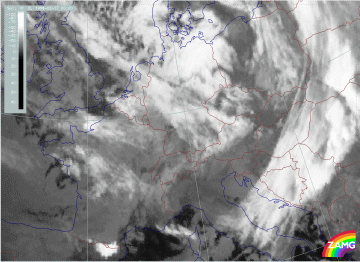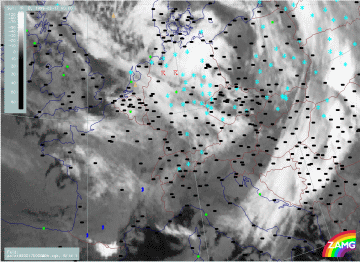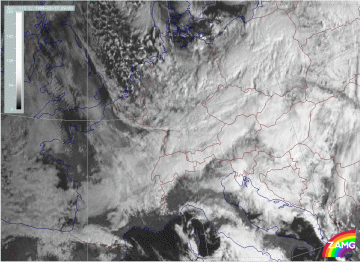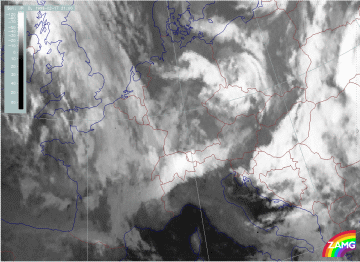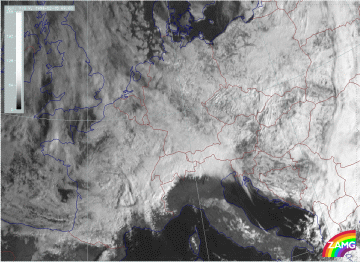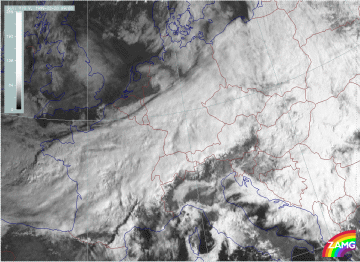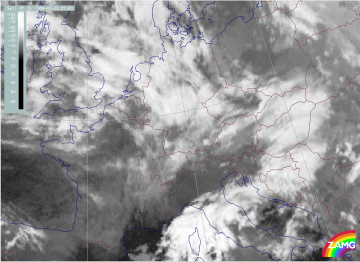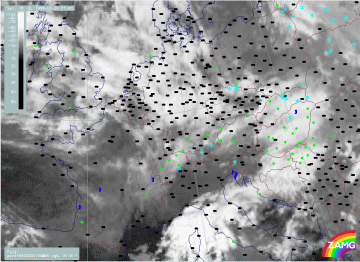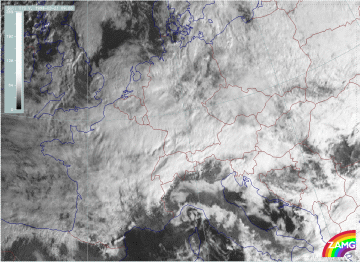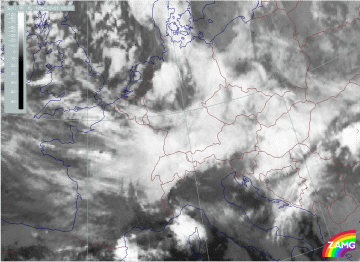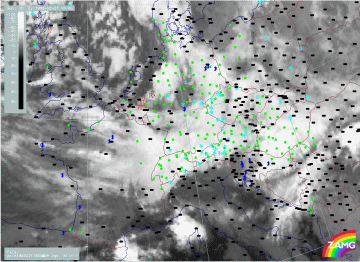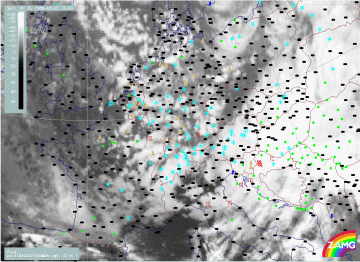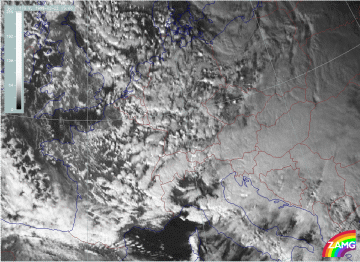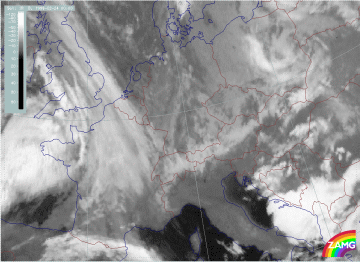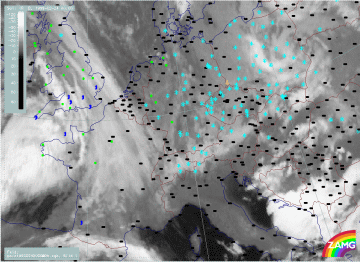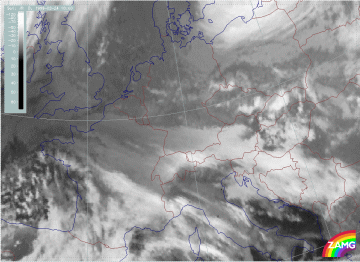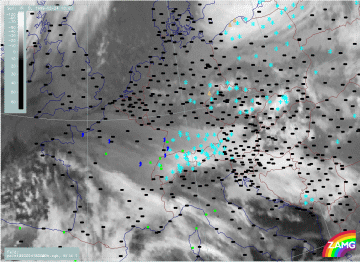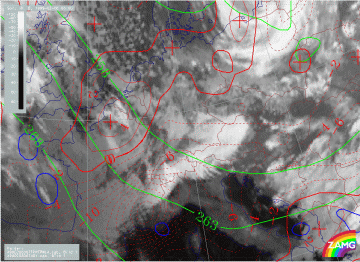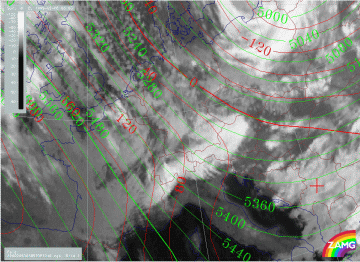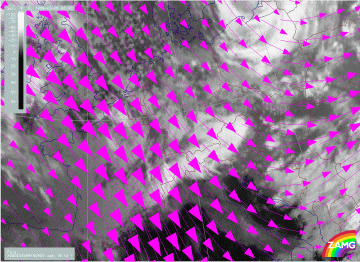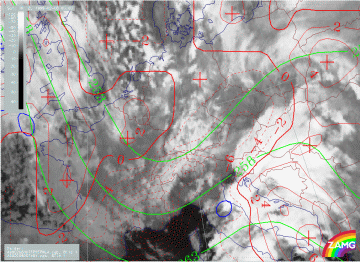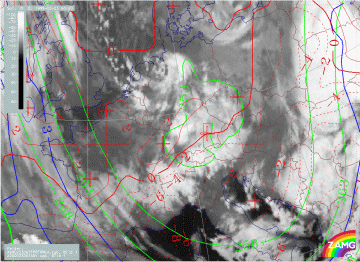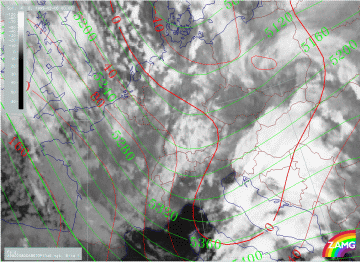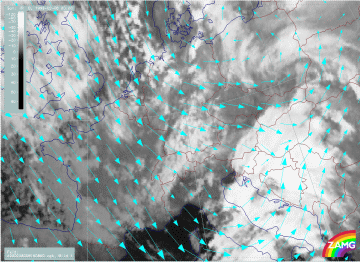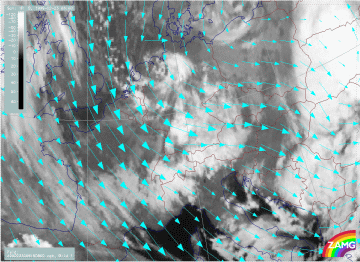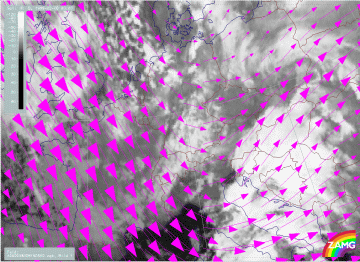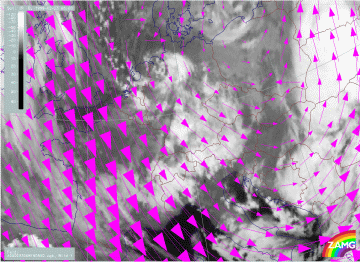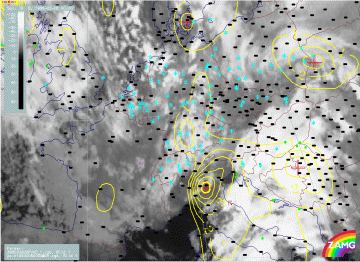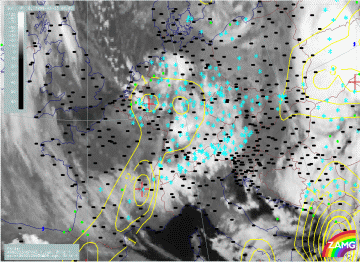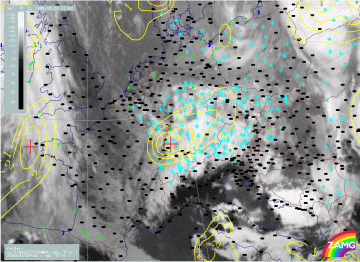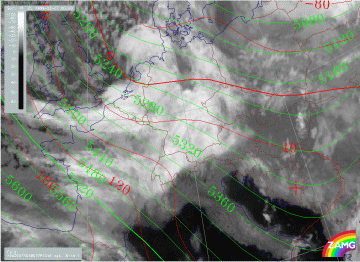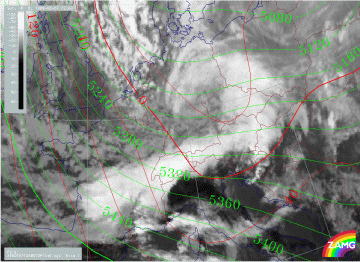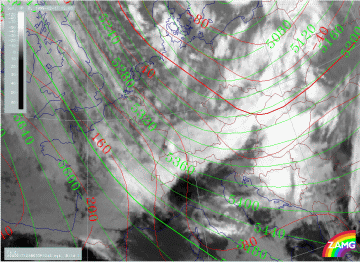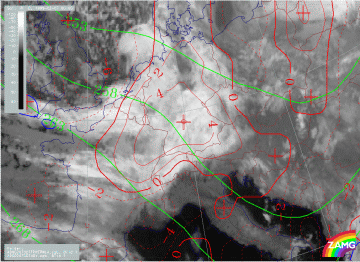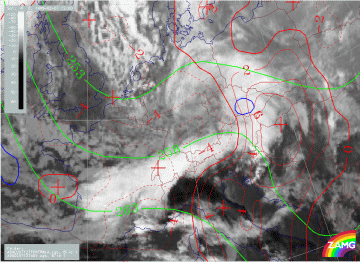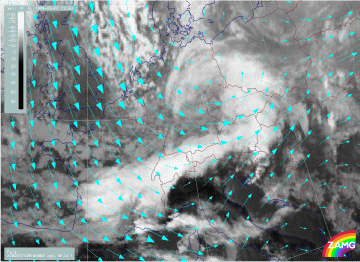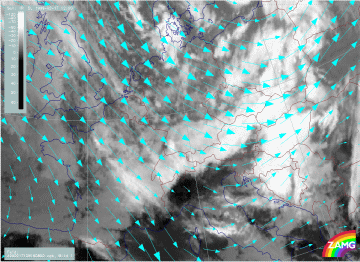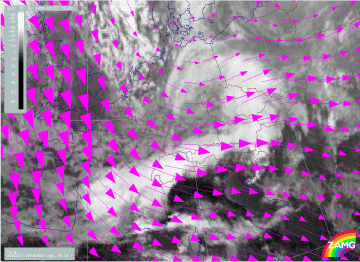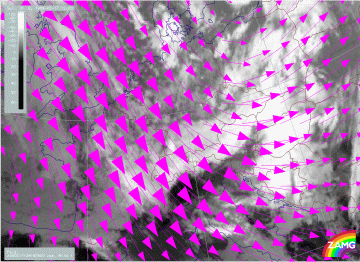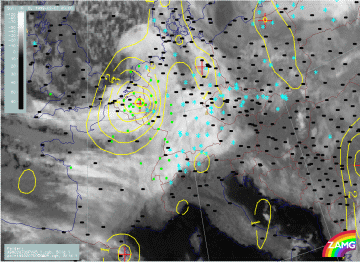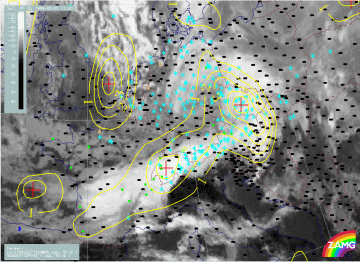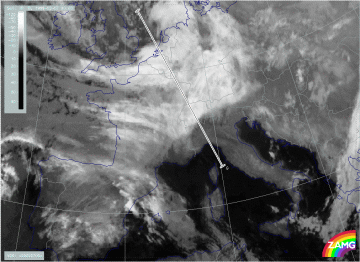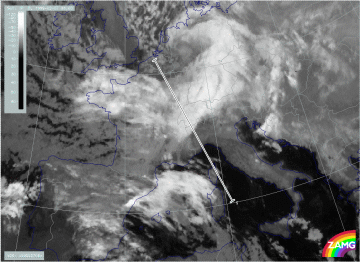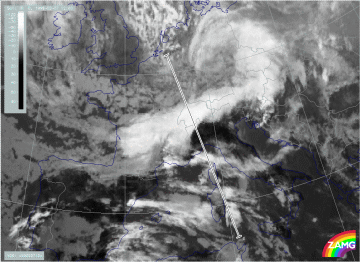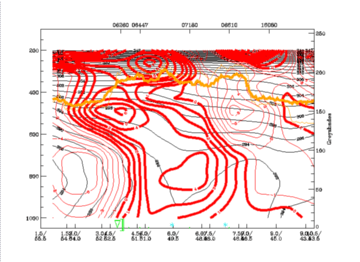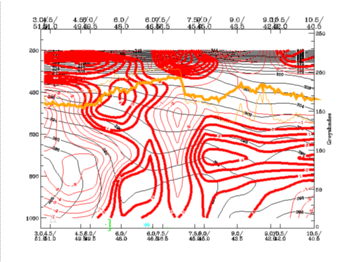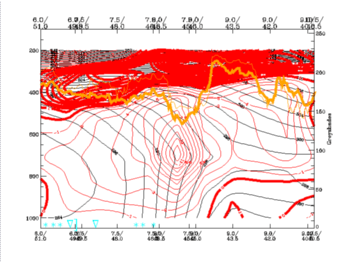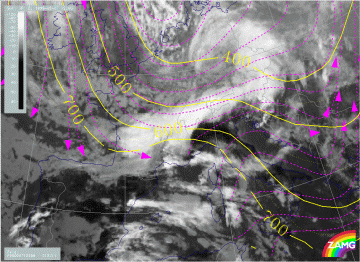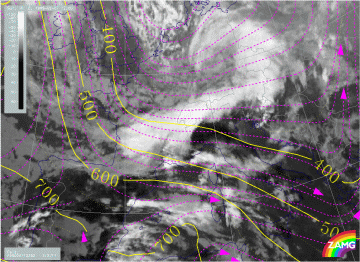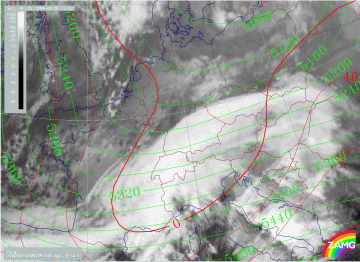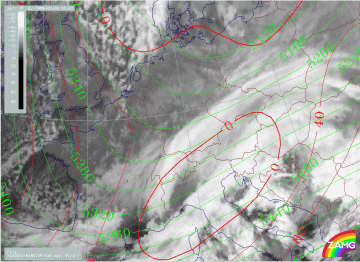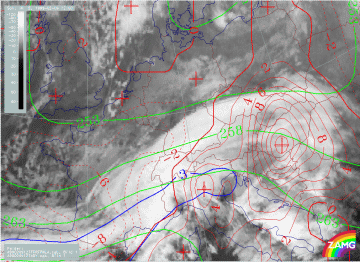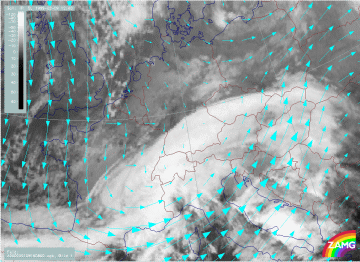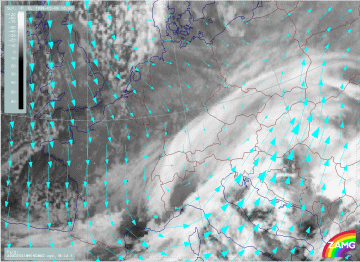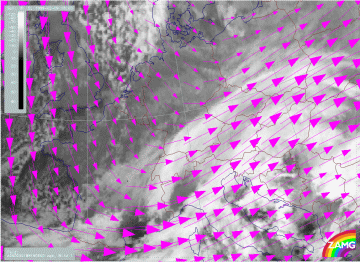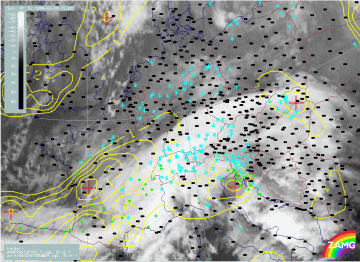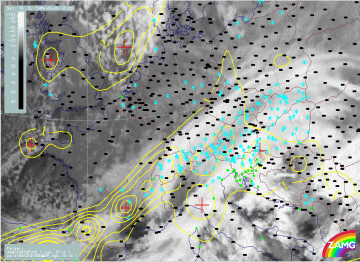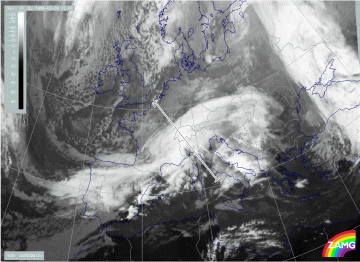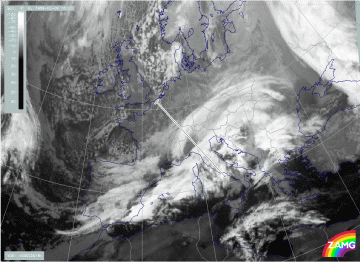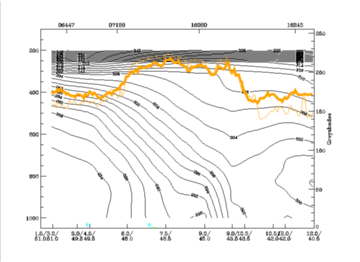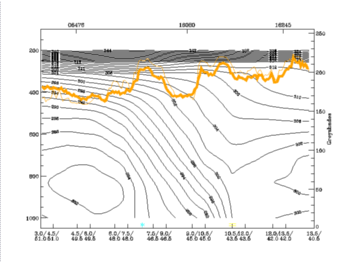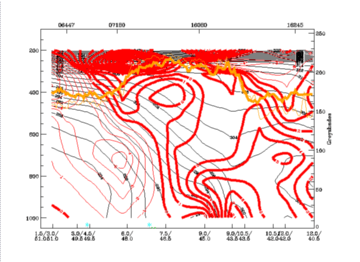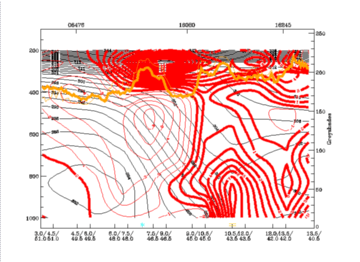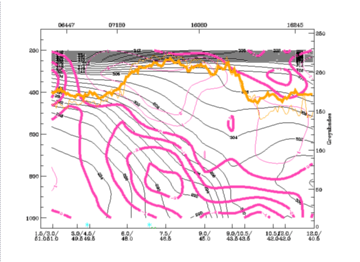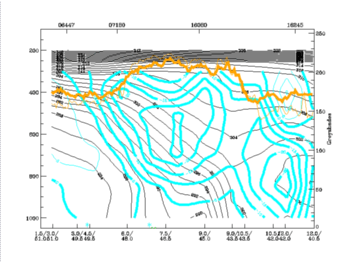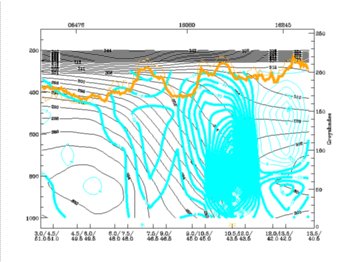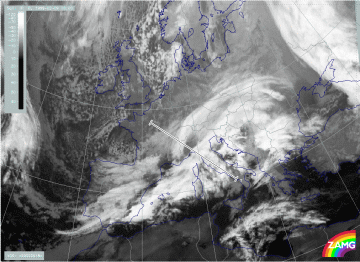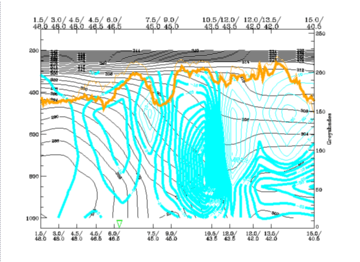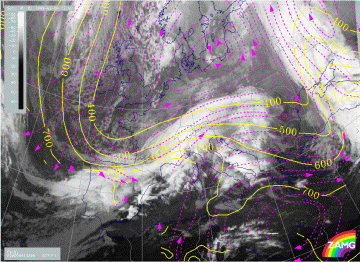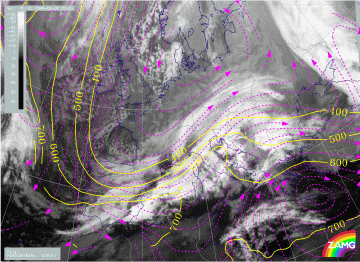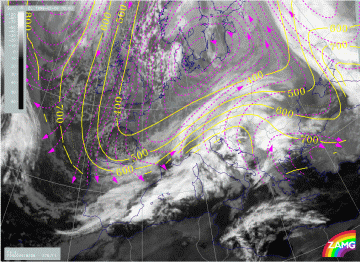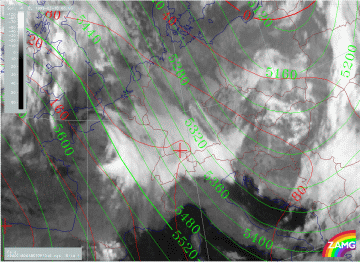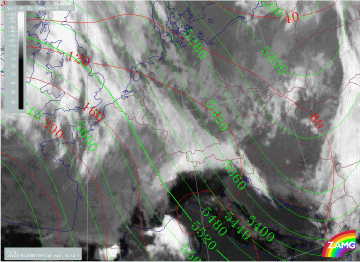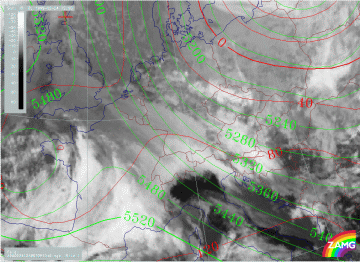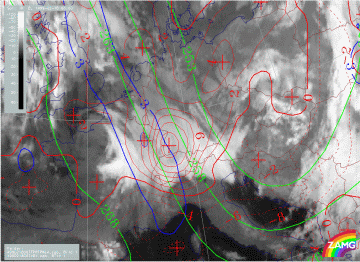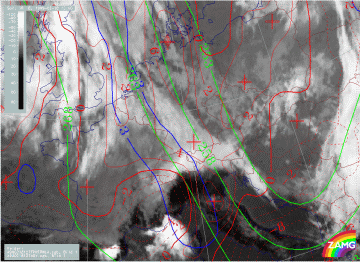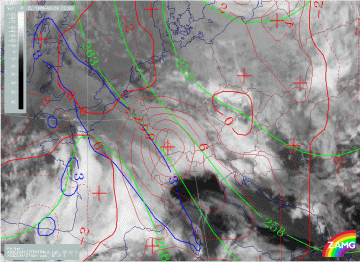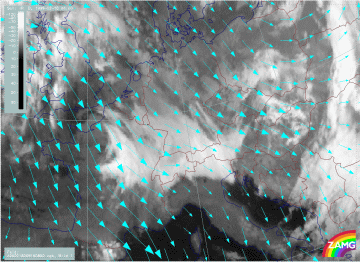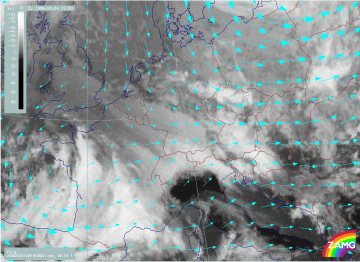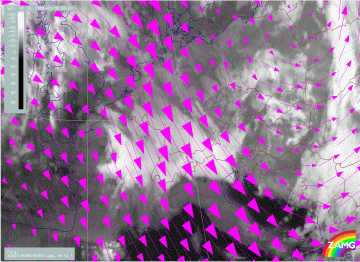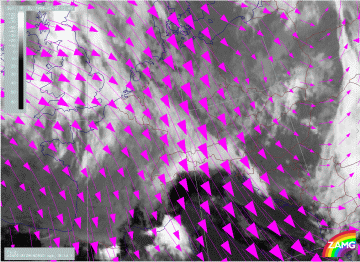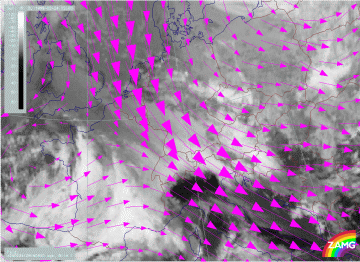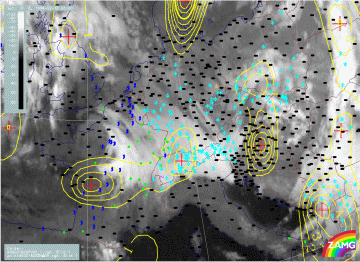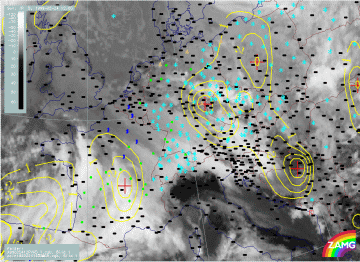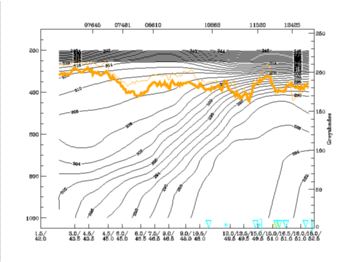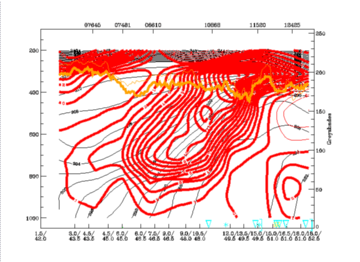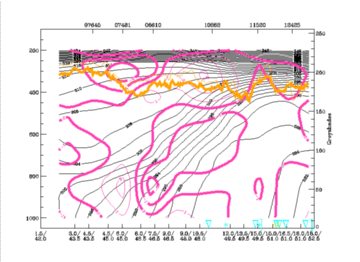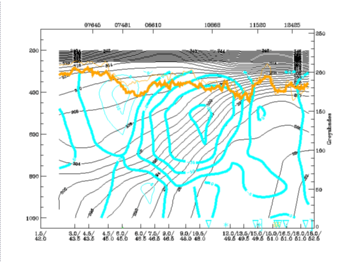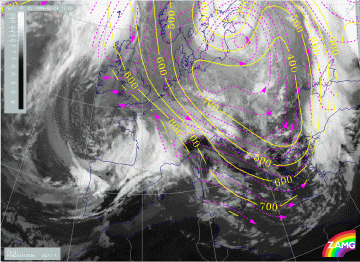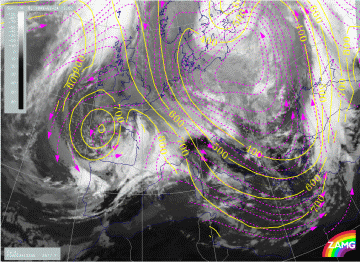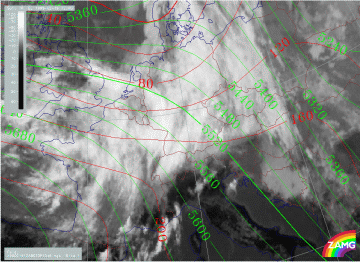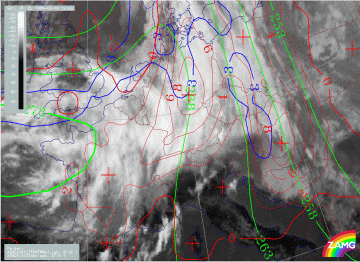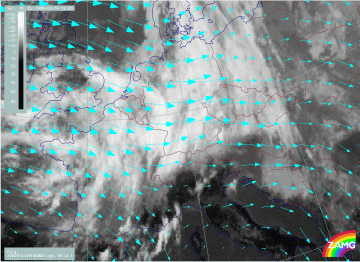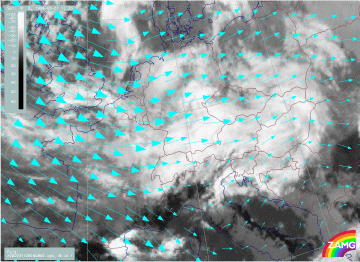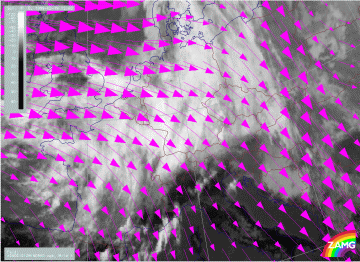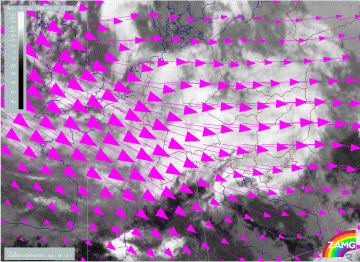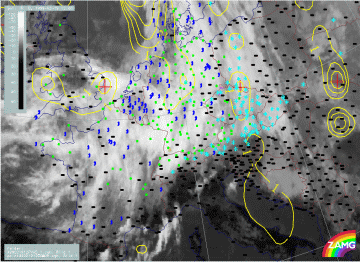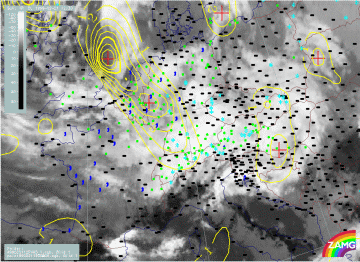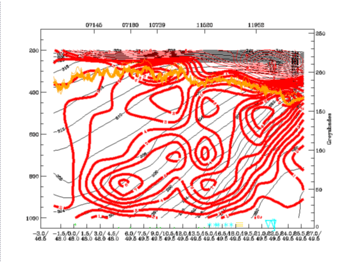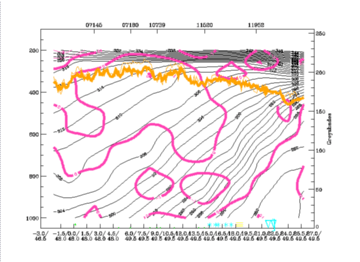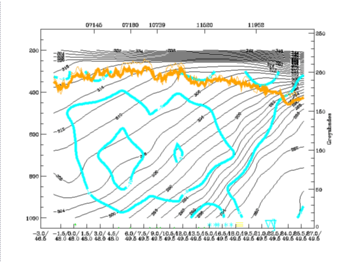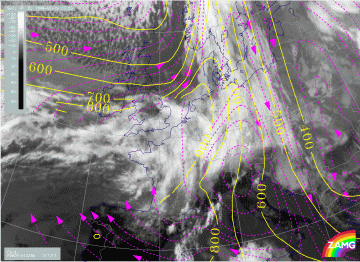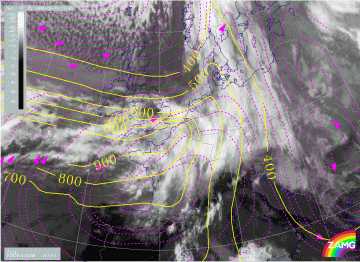Table of Contents
Introduction
There was a long period during February 1999 where the Alpine region was affected by intense precipitation, mostly snowfall. Although the regions where the main snowfall intensity was observed changed throughout the whole period, two sub-periods can be selected where precipitation took place over the whole Alpine mountain range:
- 05 - 10 February
- 17 - 25 February
The consequence of this long and intensive snowfall were many catastrophic avalanche events in all the Alpine countries like France, Switzerland and Austria. For ZAMG, as author of this case study, the avalanche catastrophe in Galtuer (Tyrol) with more than 30 dead persons is documented best.
The graphics show the cumulative heights of new snow for Galtuer during February 1999 as well as the relationship between new and total snow. The periods with new snow correspond to the periods mentioned above. Cumulative heights of up to 400 cm are recorded. The table shows that these amounts are the highest observed during the last 100 years. The table shows, furthermore, that also for other villages in the Austrian Alpine area the snow heights were highest or the second highest since records began.
The main reason for the catastrophic avalanche events are not single weather situations and/or conceptual models but the persistance of weather situations (conceptual models) that are associated with winds having a normal component to the Alps and therefore creating Stau precipitation.
The case study is divided into an overview part where 3-hourly satellite images and precipitation reports are presented chronologically in the form of 12 phases, each comprising a different synoptic situation and/or development.
Then, the main synoptic processes that occurred in this period during these chronological phases are summarized and examinde in detail with the help of typical examples.
Overview
Phase 1: 05 February/06.00 - 06 February/12.00 UTC
This phase is characterised by:
- A thickness gradient forming a trough feature exactly over the Alpine area
- Non frontal conditions
- CA dominates
- PVA plays an additional role
- Stau cloud features
- Wind components at 850 hPa are mainly from NW
- Wind components at 500 hPa are mainly from NW
|
05 February 1999/06.00 UTC - Meteosat IR image; 05/06.00 - 06/12.00 UTC 3-hourly image loop
|
|
The main cloud features are Stau Clouds: in the beginning low Stau Clouds do exist but cloud tops are increasing in height during the rest of the phase. Special features are:
- The sharp boundary at the main mountain range forming a bow extending throughout Austria. In the beginning this bow is only a dark grey line (ph101: 06.00 UTC) which intensifies and finally forms a triangular shaped broad, bright Stau Cloud band (ph103: 12.00 UTC).
- Cold Stau Cloud extending far into the South of the Alps (S. Tyrol and Upper Italy; ph107: 06/00.00 UTC). This seems to go hand in hand with the crossing of a convective cloud band (compare loop of weather events below).
- Parallel lines within the Stau Cloud south of and perpendicular to the main mountain chain (ph109: 06/06.00 UTC) over N. Italy and especially ph111, 06/12.00 UTC over Slovenia and
Croatia; these lines might be superimposed Lee Cloud that
- starts at single mountains within the region of highest mountains,
- undergoes descent immediately to the south of the highest mountains which leads to a small area of cloud dissipation (Carinthia - Styria) and
- forms again more to the south (Slovenia - Croatia)
|
05 February 1999/06.00 UTC - Meteosat IR image; weather events (green: rain and showers, blue: drizzle, cyan: snow, red: thunderstorm with precipitation, purple: freezing rain, orange:
hail, black: no actual precipitation or thunderstorm with precipitation); 05/06.00 - 06/12.00 UTC 3-hourly image loop
|
|
- There is precipitation in the Alpine region throughout the whole period;
- During a short phase (05/21.00 - 06/00.00 UTC) precipitation is concentrated only on the mountains. But during the rest of the phase precipitation is also widespread north and north-west of the Alps in Germany and France.
- In the beginning of this phase (05/06.00 - 05/15.00 UTC), snow exists only in the high Alpine mountain ranges while north and north-west of the Alps rain prevails. This changes from 05/15.00 UTC onwards to snow. Only over Switzerland rain events can be observed longer, until about 06/06.00 UTC.
- The phenomenon of a southward moving small convective cloud band which crosses the Alps shows up very dramatically in the weather reports with a line of thunderstorms which even reach E. Austria at 05/15.00 UTC.
|
05 February 1999/09.00 UTC - Meteosat VIS image; 09.00 - 15.00 UTC 3-hourly image loop
|
|
Stau clouds in the VIS images are quite impressive. Main features are:
- The sharp boundary of the Stau Cloud at the highest mountain range with snow covered mountain ranges to the south (ph104v: 05/12.00 UTC)
- The sharp northern boundary of the Stau Cloud through Bavaria (ph103v: 05/12.00 UTC)
- Parallel band-like structures north of the Alps superimposed on the Stau Cloud but perpendicular to it (ph102v: 05/09.00 UTC and ph104v: 05/15.00 UTC)
For a detailed example see: Thickness gradient forming a trough
Phase 2: 06 February/18.00 - 07 February/18.00 UTC
This phase is characterised by:
- Sequence of frontal passages:
- Approach of a WA maximum and increase of WA cloud north of Alps
- Cold Air Development (CAD) from a Comma feature north of Alps and subsequent crossing of the Alps
- Non frontal conditions for the CAD phase
- Changing conditions of Temperature Advection (TA): CA - WA - CA
- PVA plays an additional role, especially in the CAD phase
- Main cloud features are: Stau features, CAD
|
06 February 1999/15.00 UTC - Meteosat IR image; 06/15.00 - 07/18.00 UTC 3-hourly image loop
|
|
- During the first phase from 06/12.00 to 21.00 UTC (ph201 - ph203), fibrous cloudiness typical of a Detached Warm Front develops north and north-west of the Alps.
- At the same time there are distinct Stau features at the Alps with a distinct southern boundary extending from NW. Italy across S. Tyrol into Austria, where it ends at the main mountain chain of the "Hohe Tauern". So this southern boundary of the Stau Cloud is quite far to the south (east) of the highest mountain chains.
- At 06/21.00 UTC, the fibrous Warm Front cloudiness becomes more widespread over Germany which is in front of a Comma configuration developing over the North Sea. This Comma develops further and moves southward approaching the Alpine region.
- From 07/00.00 UTC (ph204) onwards, the Stau Cloud changes insofar as the distinct southern boundary moves northward: Mountain chains in SE. Switzerland and S. Tyrol become cloud free and their snow cover becomes visible. This process continues until about 07/06.00 UTC (ph206), when Stau Cloud prevails only north of the mountain chain in Austria.
- There is also a tendency during this phase that Lee Cloud is produced over North Croatia moving into SW Hungary.
- At the same time, but especially from 07/06.00 UTC onwards, the approaching increased Comma (Cold Air Development CAD) forms a distinct cloud band north of the Alps which covers the Alps at 12.00 UTC (ph208).
- During this phase Stau Cloud can only be observed over the W. Alps with a distinct south-eastern boundary extending quite far into NW. Italy.
- At the same time high Lee Cloudiness has developed in two areas, one starting at the French Central Mountains and the second one at the French W. Alps.
- A very interesting development takes place between 07/12.00 and 18.00 UTC (ph208 - ph210) with the passage of the Comma cloud band over the Alps. There seems to be a jump of the frontal
cloud band from a position over the Alps at 12.00 UTC to a position far south of the Alps (S. France - Corsica - Slovenia) at 18.00 UTC. Looking at a half hourly image sequence (not
shown here) one can see three main points:
- Cloudiness intensifies in the region of the Lee Cloud mentioned for 12.00 UTC, that means south of the Alps.
- Part of the cloud band remains over the Alpine mountain area but becomes lower in height
- A high level cloud feature seen very well at 07/15.00 UTC (ph209) over the highest mountain chain moves across the Alps and merges with the intensified cloud area south of the Alps.
- Synoptically, the most interesting is the first (a.), describing the intensification of cloudiness south of the Alps. This is an effect which can be observed frequently and might be explained by a pre-upper level front which either develops south of the Alps, or is moved across the mountains by the faster upper level flow.
|
06 February 1999/15.00 UTC - Meteosat IR image; weather events (green: rain and showers, blue: drizzle, cyan: snow, red: thunderstorm with precipitation, purple: freezing rain, orange:
hail, black: no actual precipitation or thunderstorm with precipitation); 06/15.00 - 07/18.00 UTC 3-hourly image loop
|
|
The following points can be summarized:
- There is precipitation within, north and north-west of the Alpine region during the whole phase.
- Over Austria and Bavaria snow prevails but over Switzerland and especially over W. Switzerland there is rain till at least 07/09.00 UTC
- At 07/09.00 UTC, high cloudiness increases over the southern areas of Austria associated with the approaching Comma; but it is not prouducing precipitation; snow still is only reported from the Stau Cloud areas;
- There are no precipitation reports in the area of the newly developed cloud band south of the Alps at 07/15.00 UTC.
|
06 February 1999/15.00 UTC - Meteosat VIS image; 06/15.00 - 07/15.00 UTC 3-hourly image loop
|
|
The most interesting feature in the VIS images from 07/09.00 to 15.00 UTC relates to the crossing of the Comma cloud band (features looking like a jump of frontal cloudiness):
- Dramatic development of cloudiness south of the Alps in the area of the Lee Cloud between 12.00 and 15.00 UTC (ph208 - ph209)
- Southward moving high cloud boundary over the Apine region between 12.00 and 15.00 UTC (especially distinct over Switzerland)
For a detailed example see: Comma feature (Cold Air Development CAD)
Phase 3: 08 February/00.00 - 08 February/12.00 UTC
This phase is characterised by:
- Thickness trough
- Non frontal conditions
- CA dominates
- Main cloud features: Stau features (approaching WF from W)
|
07 February 1999/21.00 UTC - Meteosat IR image; 07/21.00 - 08/12.00 UTC 3-hourly image loop
|
|
In summary, the following can be noted:
- Stau Cloud features are not very distinct at the beginning of this phase (ph301: 07/21.00 UTC).
- There are clouds north of the Alps extending far into Germany at the beginning of this phase.
- From 08/09.00 UTC (ph305) on, Stau Cloud features become more distinct and intensive over the W. Alps; such an effect goes hand in hand with the approach of Warm Front cloudiness.
- Intensification of Stau Cloudiness together with approaching synoptic scale cloudiness can be observed frequently during this case study.
|
07 February 1999/21.00 UTC - Meteosat IR image; weather events (green: rain and showers, blue: drizzle, cyan: snow, red: thunderstorm with precipitation, purple: freezing rain, orange:
hail, black: no actual precipitation or thunderstorm with precipitation); 07/21.00 - 08/12.00 UTC 3-hourly image loop
|
|
In summary, the following can be noted:
- Snow reports are widespread within the Alpine region.
- Snow reports are also widespread north of the Alps over Germany.
|
08 February 1999/09.00 UTC - Meteosat VIS image; 08/09.00 - 08/12.00 UTC 3-hourly image loop
|
|
- Cloudfree snow-covered mountain ranges over N. Italy very pronounced
- Boundaries of higher cloud fields in connection with synoptic scale Warm Front cloud over the W. Alps very distinct, especially at 08/09.00 UTC
For a detailed example see: Thickness trough
Phase 4: 08 February/18.00 - 10 February/18.00 UTC
This phase is characterised by:
- Sequence of crossing frontal systems:
- Warm Front
- Cold Front
- Wave formation south of Alps
- Main cloud features: Stau at W. Alps, Lee clearing after Cold Front passage
|
08 February 1999/15.00 UTC - Meteosat IR image; 08/15.00 - 10/18.00 UTC 3-hourly image loop
|
|
The complete phase can be divided in three sub-phases representing different synoptic conditions:
1. Warm Front passage (08/18.00 - 09/06.00 UTC)
In summary, the following can be noted:
- Between 08/15.00 UTC to 09/06.00 UTC, a Warm Front Band moves from France across the W. Alps further eastward until it covers the whole of Austria and even parts of W. Hungary; at the end of this phase the Warm Front cloud in Austria ends abruptly at the northern boundary of the Alps.
- Sub-structures within the Warm Front cloud can be observed, especially the parallel fibres oriented perpendicular to the Alps. For this phenomenon lee waves have been mentioned as a possible explanation. At 09/12.00 UTC (ph408), a single fibre extends from the highest tops in Austria ("Hohe Tauern") eastward into E. Hungary. As the upper level stream is westerly, Lee Clouds might be a reasonable explanation here as well.
- Cloudiness crosses the Alpine mountains and reaches quite far into Italy, especially at the eastern leading edge of the cloud shield - a cloud feature very similar to those observed with Detached Warm Fronts.
- Between 09/00.00 UTC and 09/06.00 UTC, intensive Stau develops at the W. Alps (France and Switzerland) which is a location to the rear of the Warm Front cloud but in front of the approaching Cold Front.
- At 09/09.00 UTC, Cold Front cloudiness has approached the W. Alps and Stau Cloud is hidden within a more extended cloud field.
2. Cold Front passage (09/12.00 - 09/18.00 UTC)
In summary, the following can be noted:
- At 09/12.00 UTC, the Cold Front cloud band has reached the W. Alps and later (between 12.00 and 15.00 UTC) propagates into N. Italy.
- At 09/18.00 UTC (ph410) some remarkable cloud configurations appear:
- The Cold Front cloud band which is south of the Alps over Italy
- A remarkable cloud free part in the lee of the W. Alps over N. Italy called "Lee clearing"
- An Occlusion - like cloud band extending from the E. Alps over Bavaria to the W. Alps
- The 1/2 hourly detailed image sequence (not shown here) shows that there is already some "Lee clearing" between 13.30 and 15.00 UTC and pronounced Lee clearing from 15.00 UTC on.
- The Occlusion - like cloud band is definitely not an Occlusion but a substructure in the Cold Front cloud band which is held back in the Alpine mountains and probably increased by Stau effects.
- In the 1/2 hourly detailed image sequence the remainder of this band moves eastward from 18.30 to Tyrol.
- There are very pronounced high Lee Clouds over the Apennine and the mountains in Bosnia and Yugoslavia at 09/12.00 UTC (ph408).
3. Wave development south of the Alps (10/00.00 - 18.00 UTC)
In summary, the following can be noted:
- There is an indication of a small Wave between 10/00.00 and 03.00 UTC over N. Italy and Tyrol; but instead of a further increase in cloud, at 06.00 UTC (ph414) dissipation takes place in this area.
- At 10/09.00 UTC, a new indication for a Wave formation can be observed close to Corsica.
- Rapid development of Wave formation and of a Cold Conveyor Belt (CCB) Occlusion takes place during the next hours.
- In the end the CCB Occlusion band is situated over Central and W. Austria while the Warm Front area affects E. Austria.
|
08 February 1999/15.00 UTC - Meteosat IR image; weather events (green: rain and showers, blue: drizzle, cyan: snow, red: thunderstorm with precipitation, purple: freezing rain, orange:
hail, black: no actual precipitation or thunderstorm with precipitation); 08/15.00 - 10/18.00 UTC 3-hourly image loop
|
|
The complete phase can be divided in three sub-phases representing different synoptic conditions:
1. Warm Front passage (08/18.00 - 09/06.00 UTC)
In summary, the following can be noted:
- Snow is approaching with the Warm Front cloud shield; rain appears only in the western and south-western parts over France.
- Until 09/00.00 UTC snowfall has covered the whole of Switzerland and moves very slowly eastward over Tyrol to Central Austria.
- The leading cloud shield over E. Austria remains precipitation free.
2. Cold Front passage (09/12.00 - 09/18.00 UTC)
In summary, the following can be noted:
- There is extended snowfall in the Alpine mountains and snowfall in the Cold Front cloud band to the south of the Alps.
- The Occlusion - like cloud band only consists of middle/high cloud without precipitation over the Czech Republic and Bavaria.
3. Wave development south of the Alps (10/00.00 - 18.00 UTC)
In summary, the following can be noted:
- There is intensive snow south-south-east and east of the Alps during the whole period.
- Snowfall becomes less over Switzerland, with even precipitation free periods, and also over the western parts of Austria.
|
08 February 1999/15.00 UTC - Meteosat VIS image;
|
|
The complete phase can be divided in three sub-phases representing different synoptic conditions:
1. Warm Front passage (08/18.00 - 09/06.00 UTC)
In summary, the following can be noted:
- The VIS image from 08/15.00 UTC (ph401v) shows the thick, well developed, Warm Front cloud band over France and the W. Alps.
- Very well developed small Lee Cloud bands can be observed over S. France in the lee of the French Central Massif range.
- Another Lee Cloud phenomenon over Carinthia and N. Italy is very interesting: parallel lines perpendicular to the Alpine mountain chain; those lines start at single high mountain and change somewhat in their width. This is very similar to ph111 over Slovenia - Croatia where the parallel lines perpendicular to the Alpine mountains also appear in advance of a Warm Front cloud band.
2. Cold Front passage (09/12.00 - 09/18.00 UTC)
In summary, the following can be noted:
- The VIS images from 09/12.00 and 15.00 UTC (ph408v - ph409v) show several areas of parallel Lee Cloud bands, especially over Italy and Bosnia. At 09/12.00 UTC VIS and IR images (ph408, ph408v) show Lee Cloud at two levels: parallel lines with warm tops are much clearer in the VIS image and high Lee Cloud fields with cold tops much clearer in the IR image.
- Parallel lines superimposed upon the Stau cloud in the W. Alps south of Switzerland can be identified more easily in the VIS image. There may be similarities to the situation over the French Central Massif (high lee fibres at single mountain massifs) and therefore a similar situation as already mentioned twice for an area south of the Alps (N. Italy, Slovenia, Croatia).
- Stau at the W. Alps and an increasing cloud free area to the lee of the W. Alps can also be observed.
3. Wave development south of the Alps (10/00.00 - 18.00 UTC)
In summary, the following can be noted:
- The VIS image shows the intensive thick cloud mass south and east of the Alps with a dense white cloud area.
- Snow structures in the W. Alps; lakes and valleys are visible and the snowline seems to be very low.
For a detailed example see: Comma feature (Cold Air Development CAD) and Detached Warm Front and subtypes
Phase 5: 17 February/00.00 - 17 February/18.00 UTC
This phase is characterised by:
- Crossing of Comma system
- Thickness gradient forming a trough
- Non frontal conditions
- CA dominating
- PVA plays additional role especially with Comma feature
- Main cloud features: Stau features, Comma
|
17 February 1999/00.00 UTC - Meteosat IR image; 00.00 - 18.00 UTC 3-hourly image loop
|
|
In summary, the following can be noted:
- Between 17/00.00 and 06.00 UTC (ph501 - ph503), the cloud fibres of a Warm Front Band extend from the NW (North Sea initially) to the highest mountain chain of the Alps in Austria and, later, also in Switzerland.
- North of this Warm Front Band, several cold air features develop; of special importance is a Comma feature which moves from the North Sea to a location over Germany to Poland.
- During this sub-phase between 17/03.00 - 06.00 UTC, very distinct high Lee Cloud fibres develop at the E. Alps and extend from E.-SE. Austria and the E. Czech Republic into Slovakia and Hungary.
- At 17/09.00 UTC (ph504), the Comma is already so close to the Alps that a new area of cloudiness appears: there is Stau north of the Alps, especially over Central and E. Austria with the Comma cloud tail immediately north of it.
- The crossing of the Comma itself occurs between 17/12.00 and 18.00 UTC (ph505 - ph507) with the following cloud configurations:
- A merging between Stau and Comma tail cloud forming the typical bow-like Stau structure in Central and E. Austria.
- Comma tail cloudiness including Stau Cloud moves southward ending at the southern mountain chains of the Alps at 17/15.00 UTC
- New Comma tail cloud forms south of the Alps over Slovenia and Hungary with a distinct cloud-free stripe in between some remnants of Stau Cloud in the Alpine region and the Comma cloud tail.
- The latter phenomenon is a very nice example of synoptic and mesoscale systems, and their associated cloudiness and physical featurs crossing the Alps more or less unchanged. Changes in the cloud structure appear only during the Alpine passage itself.
|
17 February 1999/00.00 UTC - Meteosat IR image; weather events (green: rain and showers, blue: drizzle, cyan: snow, red: thunderstorm with precipitation, purple: freezing rain, orange:
hail, black: no actual precipitation or thunderstorm with precipitation); 00.00 - 18.00 UTC 3-hourly image loop
|
|
In summary, the following can be noted:
- There are reports of thunderstorms within the Comma tail during the whole phase from its formation over the North Sea and Germany to its arrival at the Alpine mountains.
- At the beginning of this phase there are only some reports of snow in the Alpine region.
- Snow events in the Alps increase first in the Stau area north of the Alps during the approach of the Comma, and then within the Alps during the crossing of the Comma.
- The newly formed Comma cloud south of the Alps at 17/18.00 UTC is no longer accompanied by widespread precipitation but only by some reports of snow.
|
17 February 1999/09.00 UTC - Meteosat VIS image; 09.00 - 15.00 UTC 3-hourly image loop
|
|
The following fact can be summarized:
- During the phase 17/9.00 - 15.00 UTC the merging of the two separate cloud systems "Stau" and "Comma tail" is easily recognisable in the VIS images.
For a detailed example see: Comma feature (Cold Air Development CAD)
Phase 6: 18 February/00.00 - 20 February/06.00 UTC
This phase is characterised by:
- The crossing of two WF/WA systems with thickness gradients:
- Detached Warm Front
- Warm Front Shield
- Transition at the end of the period
- WA dominates
- Main cloud features are: Stau features, fibrous Warm Front cloud
|
17 February 1999/21.00 UTC - Meteosat IR image; 17/21.00 - 20/00.00 UTC 3-hourly image loop
|
|
In summary, the following can be noted:
- At the beginning of this phase, 17/21.00 - 18/00.00 UTC (ph601 - ph602), the cloudiness of a Warm Front band is extending from France to the W. Alps and there is Stau Cloud over Switzerland, extending from there eastward to Tyrol; the Stau Cloud reaches the southernmost mountain chains over N. Italy.
- Between 18/03.00 - 12.00 UTC (ph603 - ph606), cloudiness associated with this Warm Front separates from the north-western systems and develops the typical cloud configuration of a Detached Warm Front. A main characteristic is the clouds at the leading side of the Detached Warm Front crossing the Alps in southward direction to South Tyrol and moving from there eastward and at the same time, with high upper level wind, southward across Slovenia and the Croatian coast. At the same time the leading edge of the Detached Warm Front cloud north of the Alps has only reached Salzburg (Central Austria).
- From 18/15.00 UTC (ph607) onwards, the Warm Front cloud band north of the Alps is fed by a new system propagating eastward from France across Switzerland. The two different cloud heights can easily be discriminated.
- Between 18/15.00 - 19/00.00 UTC (ph607 - ph610), the most interesting phenomena are intensive Stau Cloud from Switzerland to Central Austria. But this Stau reaches only to the highest mountain chains or slightly further to the south. But SE Switzerland, N. Italy and Carinthia are cloud free.
- From 19/00.00 UTC (ph610) on, the leading edge of this cloud propagates very quickly and extends south-eastward over Hungary and Croatia.
- At the same time, but especially from 19/09.00 - 20/00.00 UTC (ph613 - ph618), fibrous clouds from a new Warm Front Shield propagate from France westward first to the W. Alps (Switzerland) but later also to E. Austria.
- This new Warm Front cloud merges with the old Warm Front cloud and moves eastward quite quickly to E. Austria. The southern cloud boundary is at the highest mountain chain.
- From 19/00.00 UTC on, cloud features become more diffuse and indicate a change in the synoptic situation.
|
17 February 1999/21.00 UTC - Meteosat IR image; weather events (green: rain and showers, blue: drizzle, cyan: snow, red: thunderstorm with precipitation, purple: freezing rain, orange:
hail, black: no actual precipitation or thunderstorm with precipitation); 17/21.00 - 20/00.00 UTC 3-hourly image loop
|
|
In summary, the following can be noted:
- There is a lot of precipitation within this phase, in and north of the Alpine region.
- Some additional facts worth mentioning concerning the first detached Warm Front phase 17/21.00 - 18/12.00 UTC (ph601p - ph606p):
- The Detached Warm Front in the first phase generates snow.
- The fibrous cloud parts south of the Alps are middle and high cloud and not accompanied by any precipitation.
- The second Warm Front band, merging with the first, approaches with rain from 18/18.00 - 21.00 UTC (ph607p - ph609p) only in the westernmost parts, especially over W. to SW. Switzerland. By 19/00.00 UTC (ph610), the rain area extends eastward to W. Austria (Vorarlberg) and Bavaria. Tyrol still reports snowfall.
- The main rain event approaches with the Warm Front cloud shield between 19/09.00 - 20/00.00 UTC (ph613p - ph618p) and ultimately covers the whole Alpine region (except for the highest mountains where, of course, snow prevails).
- It was this warm air outbreak, together with rain, that was a primary cause for the later avalanches. Snow melted during this warmer phase but froze again during the subsequent phases so that the new snow lying on top of this frozen layer was not bonded to it and was accelerated while sliding downhill.
|
18 February 1999/09.00 UTC - Meteosat VIS image; 18/09.00 - 19/15.00 UTC 3-hourly image loop
|
|
In summary, the following can be noted:
- The first phase covered by VIS images shows the Detached Warm Front cloud and the fibre crossing the Alps at the leading edge. Only the southernmost mountain chains over N. Italy are cloud free; but cloudiness covering the mountains over N. Italy is translucent and therefore only high Lee Cloudiness.
- The second phase covered by VIS images shows the approach and eastward movement of the Warm Front Shield. Here, Stau cloud do not cross over the main mountain chain.
For a detailed example see: Detached Warm Front and subtypes and Classical Warm Front shields
Phase 7: 20 February/12.00 - 20 February/18.00 UTC
This phase is characterised by:
- Cold Front crossing
- Development of Stau Cloud having features similar to an Occlusion
- CA dominates
- Main cloud features: Stau features, CF, Lee clearing after Cold Front passage
|
20 February 1999/06.00 UTC - Meteosat IR image; 20/06.00 - 20/18.00 UTC 3-hourly image loop
|
|
In summary, the following can be noted:
- At the beginning of this phase, 20/06.00 UTC (ph701), Stau Cloud exists at the Alps (W. Austria) and a broad Cold Front cloud band extends from the European NW coast to the Alps.
- Between 20/09.00 - 12.00 UTC (ph702, ph703) this frontal cloud band quickly approaches towards the Alps; Stau Cloud features are still recognisable over W. Austria and Switzerland.
- At 20/15.00 UTC (ph704), the cloud band lies partly over and partly south of the Alps. Over NW Italy in the lee of the W. Alps, holes develop in the cloud band. There is a lower cloud band across Germany and the W. Czech Republic immediately north of the high Cold Front band. Such a situation might indicate a Split Front character. (Compare VIS image loop.)
- The 1/2 hourly image sequence (not presented here) shows distinct "Lee clearing" from 16.30 onwards; at 17.30 the frontal cloud band has completely passed the mountains; some remnants of cloud remain in the Alpine mountain area.
- This leads to a configuration at 20/18.00 UTC (ph705) that is very similar to the one discussed in phase 4, where an Occlusion - like cloud structure appears over the Alps which, in reality, is an effect of remnant cloudiness, Stau Cloudiness and deformation in a area of a secondary frontal zone.
- If the idea of a Split Front can be supported, the southern cloud band corresponds to the thick, multi-layered leading part of the Split Front, whereas the low band in the Alps corresponds to its rearward low cloud part. This can therefore directly be compared with the situation discussed in phase 4 as well as Cold Front crossing - Distinct Lee clearing.
|
20 February 1999/06.00 UTC - Meteosat IR image; weather events (green: rain and showers, blue: drizzle, cyan: snow, red: thunderstorm with precipitation, purple: freezing rain, orange:
hail, black: no actual precipitation or thunderstorm with precipitation); 20/06.00 - 20/18.00 UTC 3-hourly image loop
|
|
In summary, the following can be noted:
- The rain phase, which already started with the Warm Front passage in the previous phase, continues throughout the whole Cold Front passage.
- Snow events occur only in the highest mountain regions.
|
20 February 1999/09.00 UTC - Meteosat VIS image; 20/09.00 - 20/18.00 UTC 3-hourly image loop
|
|
In summary, the following can be noted:
- The 20/12.30 UTC image (ph703v), in particular, indicates that there are two cloud layers in the frontal cloud band; since this is not indicated in the 20/9.00 UTC (ph702v) image, a Split Front process which has already been idemtified from the IR sequence, is also supported by the VIS images.
- At 20/15.00 (ph704v), the transition between the two cloud layers is not so easy to detect as before but there are some indications of a higher cloud border at the northern boundary of Switzerland and through Bavaria. This position agrees well with the corresponding IR image.
For a detailed example see: Cold front crossing
Phase 8: 21 February/00.00 - 21 February/12.00 UTC
This phase is characterised by:
- Two Warm Front Shields crossing
- Probably no frontal conditions
- WA dominates
- Main cloud features: Stau features, Warm Front Shield cloud
|
20 February 1999/21.00 UTC - Meteosat IR image; 20/21.00 - 21/15.00 UTC 3-hourly image loop
|
|
In summary, the following can be noted:
- At 20/21.00 UTC (ph801), a Warm Front cloud band extends from the North Sea to Bavaria.
- Between 21/00.00 and 03.00 UTC (ph802 - ph803), the Warm Front clouds have intensified north of and over the Alps; the southern Stau Cloud edge corresponds to the highest mountain chains.
- Between 21/06.00 and 12.00 UTC (ph804 - ph806), clouds undergo several changes and are not always typical of a Warm Front Shield; there might also be a Cold Front - like boundary to the north. The identification as Warm Front cloudiness was made using TA in the numerical model.
- There is a better indication for a warm Front Shield in cloudiness extending from France and Germany over the Alpine region at 21/15.00 UTC (ph807). The southern edge of the Stau cloud is more to the south than at the beginning of this phase, namely over S. Tyrol (N. Italy).
|
20 February 1999/21.00 UTC - Meteosat IR image; weather events (green: rain and showers, blue: drizzle, cyan: snow, red: thunderstorm with precipitation, purple: freezing rain, orange:
hail, black: no actual precipitation or thunderstorm with precipitation); 20/21.00 - 21/15.00 UTC 3-hourly image loop
|
|
In summary, the following can be noted:
- From the beginning of this phase till 21/03.00 UTC (ph801p - ph803p) there are only some isolated reports of precipitation within and north of the Alps, mostly of rain.
- Also almost no precipitation is reported further north over Germany.
- From 21/06.00 UTC (ph804p) on, precipitation is much more frequent and extends from the whole Alpine mountain range northward to Germany.
- At 21/09.00 UTC (ph805p), a thunderstorm report near the Tyrolean - Bavarian border is rather surprising and does not fit well with the idea of a Warm Front passage.
- More snow events appear again only during the last phase.
|
20 February 1999/09.00 UTC - Meteosat VIS image; 21/09.00 - 21/15.00 UTC 3-hourly image loop
|
|
In summary, the following can be noted:
- VIS images do not add information about additional features.
- Stau Cloud is quite distinct.
For a detailed example see: Classical Warm Front shields
Phase 9: 21 February/18.00 - 22 February/12.00 UTC
This phase is characterised by:
- Crossing of (at least) two Cold Fronts and/or Commas with very intensive thickness gradient
- CA dominates
- PVA important
- Main cloud features: Stau features, Cold Front bands, Cold Front passage
|
20 February 1999/18.00 UTC - Meteosat IR image; 21/18.00 - 22/12.00 UTC 3-hourly image loop
|
|
In summary, the following can be noted:
- There are two passages of Cold Front and/or cold air features during this phase:
- First system crosses the Alps at 21/21.00 UTC (ph902);
- Second system crosses the Alps at 22/03.00 UTC (ph904);
- Between these two phases (21/21.00 - 22/03.00 UTC) a Warm Front - like feature in the eastern parts can be observed.
- During the phase 21/18.00 - 22/00.00 UTC (ph901 - ph904), distinct Stau Cloud at the W. Alps can be observed; cloudiness even lies to the south of the highest mountain chains over N. Italy.
- The second Cold Front passage (ph904 - ph907) is very pronounced with a double structure:
- frontal cloud band and
- Extended cold air features behind.
- Merging of the Cold Front cloud band and cold air features over the Alps at 22/12.00 UTC (ph904) with very intensive convective cloud structures.
|
20 February 1999/18.00 UTC - Meteosat IR image; weather events (green: rain and showers, blue: drizzle, cyan: snow, red: thunderstorm with precipitation, purple: freezing rain, orange:
hail, black: no actual precipitation or thunderstorm with precipitation); 21/18.00 - 22/12.00 UTC 3-hourly image loop
|
|
In summary, the following can be noted:
- During the first half of the phase, rain predominates within the Alpine region; snow is restricted to the highest mountain chains.
- From 22/06.00 UTC on (ph905p) (connected to the second Cold Front passage), snow events intensify first over Austria, later over Switzerland. At 22/09.00 UTC (ph906p) the rain phase has ended.
- There are many thunderstorms: during the first phase within the Cold Air Cloudiness. Within the second phase, with the intensive Cold Front passage, there are thunderstorms at the boundary between Cold Front cloudiness and Cold Air Cloud phenomena; at 22/09.00 UTC (ph906p), thunderstorms appear in Tyrol, at 22/12.00 UTC (ph907p) in Carinthia. These thunderstorms also indicate the passage of the Cold Front cloud band across the Alps.
|
22 February 1999/09.00 UTC - Meteosat VIS image; 22/09.00 - 22/15.00 UTC 3-hourly image loop
|
|
In summary, the following can be noted:
- The VIS images of 22/09.00 and 12.00 UTC reveal the double structure of cloudiness very well: the frontal cloud band itself as well as the Cold Air Cloudiness to the rear.
- There is a small stripe between the two features with some holes in cloudiness.
- The thunderstorm reports are along the northern boundary of the Cold Front band and directly at the "stripe" between the two systems.
For a detailed example see: Cold front crossing
Phase 10: 22 February/15.00 - 23 February/18.00 UTC
This phase is characterised by:
- Thickness trough
- Non frontal conditions
- WA/CA boundary immediately north of Alps but CA dominates within the Alps
- Main cloud features: Stau features, Lee features, Comma feature
|
22 February 1999/15.00 UTC - Meteosat IR image; 22/15.00 - 23/21.00 UTC 3-hourly image loop
|
|
In summary, the following can be noted:
- Between 22/15.00 and 21.00 UTC (ph1001 - ph1003), the frontal cloud band, combined with the cold air cloud band, propagate eastward across Austria; their cloudiness then moves across Central and E. Austria.
- At the same time, intensive Stau Cloud develops at the W. Alps and over W. Austria.
- In phase 22/18.00 UTC (ph1002), parallel lines are superimposed on the Stau Cloud which are perpendicular to the orientation of the Alps; such a phenomenon has already been discussed.
- The phase from 23/00.00 to 15.00 UTC (ph1004 - ph1009) is characterised by intensive Stau Cloud in the whole Alpine mountain area and by the propagation and superimposition of a Comma cloud spiral from the North Sea across the Alps. At 23/15.00 UTC (ph1009), the merging and interaction between the Stau Cloud and the cloud spiral provides some very interesting features.
- By 13/21.00 UTC (ph1011) the phases show decreasing Stau Cloud.
|
22 February 1999/15.00 UTC - Meteosat IR image; weather events (green: rain and showers, blue: drizzle, cyan: snow, red: thunderstorm with precipitation, purple: freezing rain, orange:
hail, black: no actual precipitation or thunderstorm with precipitation); 22/15.00 - 23/21.00 UTC 3-hourly image loop
|
|
In summary, the following can be noted:
- At the beginning of 22/15.00 UTC (ph1001p), there is a lot of snowfall in the Alpine mountain area and there are several thunderstorms reported within the Cold Air Cloudiness over Germany.
- Then there is a short phase 22/18.00 - 21.00 UTC (ph1002p - ph1003p) where snowfall events decrease, especially over W. Austria.
- From 23/00.00 UTC on until 23/15.00 UTC (ph1004p - ph1009p), snowfall intensifies again and extends from the Alpine mountain area across the whole of Germany; this large snowfall area is associated with the cloud features of the Stau and the Comma clouds.
- From 23/18.00 UTC onwards (ph1010p), snowfall is decreasing over Germany and restricted to the Stau Cloud in the mountains only, where it remains very heavy.
|
22 February 1999/15.00 UTC - Meteosat VIS image; 22/15.00 - 23/15.00 UTC 3-hourly image loop
|
|
In summary, the following can be noted:
- The VIS image from 22/15.00 UTC (ph1001v) shows the intensive Stau Cloud over Switzerland and pronounced convective cells over France and Germany.
- The line structure perpendicular to the Alpine mountains over the W. Alps is also recognisable.
- The approach and crossing of the Comma spiral can also be seen very clearly in the VIS images (ph1007v - ph1009v).
- The most important feature is the development of two cloud layers with different heights: the Comma head has lower cloud tops and is very cellular in structure; in the area of the Comma tail a higher cloud layer is superimposed which can be detected by a Dark Stripe caused by its shadow (ph1008v).
- However, there is a point in time at 23/15.00 UTC (ph1009v), where this shadow appears to be parallel to the highest Alpine mountain chain instead of being parallel to the Comma tail.
For a detailed example see: Thickness trough
Phase 11: 24 February/00.00 - 24 February/12.00 UTC
This phase is characterised by:
- Warm Front crossing with thickness gradient
- Warm Front maximum crossing
- Main cloud features: Stau features, Lee features, Warm Front fibres
|
24 February 1999/00.00 UTC - Meteosat IR image; 24/00.00 - 24/18.00 UTC 3-hourly image loop
|
|
In summary, the following can be noted:
- Between 24/00.00 and 06.00 UTC (ph1101 - ph 1103), Warm Front cloud fibres propagate eastwards along the Alpine mountain chains; at the same time the Stau Cloud intensifies, especially over Austria.
- Between 24/09.00 and 12.00 UTC (ph1104 - ph1105), the main feature is the development of an intensive area of cloudiness to the lee of the Alps over N. Italy, Slovenia and Croatia.
- At the same time the Warm Front cloud north of the Alps becomes more grey indicating dense but lower cloud tops. The cloud band rotates from more NW-SE to W-E directions but can still be interpreted as (Detached) Warm Front cloud.
- Only the northern edge, which is now nearly W-E oriented, seems to indicate the edge of a Cold Front or Baroclinic Boundary cloud band.
|
24 February 1999/00.00 UTC - Meteosat IR image; weather events (green: rain and showers, blue: drizzle, cyan: snow, red: thunderstorm with precipitation, purple: freezing rain, orange: hail, black: no actual precipitation or thunderstorm with precipitation); 24/00.00 - 24/18.00 UTC 3-hourly image loop
|
|
In summary, the following can be noted:
- There are reports of snow in Alpine areas as well as to the north, across the whole of Germany.
- Warm Front cloud fibres, and later developing Lee Cloudiness, are not accompanied by any precipitation.
- From 24/12.00 UTC (ph1105p) on, which is the phase when the greyer (lower) cloud tops intensify, reports of snow increase significantly within this area of cloudiness.
|
24 February 1999/09.00 UTC - Meteosat VIS image; 24/09.00 - 24/15.00 UTC 3-hourly image loop
|
|
In summary, the following can be noted:
- The VIS images from 24/09.00 - 15.00 UTC (ph1104v - ph1106v) show that the cloudiness in the lee of the Alps mostly consists of high translucent Cirrus cloud which cross the Alps without modification; it is, therefore, much higher than the mountain tops.
For a detailed example see: Detached Warm Front and subtypes
Phase 12: 24 February/18.00 - 25 February/06.00 UTC
This phase is characterised by:
- Cold Front crossing with thickness gradient
- CA dominating
- Main cloud features: Stau features
|
24 February 1999/18.00 UTC - Meteosat IR image; 24/18.00 - 25/06.00 UTC 3-hourly image loop
|
|
In summary, the following can be noted:
- The first part shows the passage of the dark grey low cloud band indicating a Cold Front.
- As already observed several times before, there is an intensification and/or new development of the cloud to the south of the mountains after the frontal passage took place (ph1201 - ph1204).
- Finally, only few clouds remain in the Alpine mountain region.
|
24 February 1999/18.00 UTC - Meteosat IR image; weather events (green: rain and showers, blue: drizzle, cyan: snow, red: thunderstorm with precipitation, purple: freezing rain, orange: hail, black: no actual precipitation or thunderstorm with precipitation); 24/18.00 - 25/06.00 UTC 3-hourly image loop
|
|
In summary, the following can be noted:
- There is much snow over Switzerland and Tyrol during the passage of the frontal cloud band.
- From 25/00.00 UTC (ph1203p), snow events decrease significantly.
Thickness gradient forming a trough
The typical synoptic situation can be summarised as:
- A thickness gradient forming a trough feature exactly over the Alpine area
- No frontal conditions (although a thickness gradient does exist)
- CA dominating
- There are phases where PVA plays an additional role
- Wind direction is mainly NW, throughout a deep layer of the troposphere
- Main cloud features: Stau features and also Lee features
|
05 February 1999/06.00 UTC - Meteosat IR image; green: equivalent thickness 500/1000 hPa, red solid: temperature advection - WA 700 hPa, red dashed: temperature advection - CA 700 hPa,
blue: Thermal Front Parameter (TFP)
|
|
A typical example is the 06/06.00 UTC (phase 1 in chronological overview) which shows intensive Stau Cloud as well as some signs of Lee Cloud. A huge thickness trough is situated over Germany and Central Europe, bound by a higher thickness gradient over the W. Alps. Since the zone of the thickness is rather broad, no fronts are indicated by a TFP line crossing the Alpine region. Despite an embedded WA maximum over France, the largest part of the trough is accompanied by CA with a maximum over the West Alps.
|
05 February 1999/06.00 UTC - Meteosat IR image; red: height contours 1000 hPa, green: height contours 500 hPa
|
|
Whilst there are northerly directions in the surface flow (1000 hPa), the upper level flow at 500 hPa shows a distinct NW direction over the whole area of the Alps. In the West Alps, over Switzerland and France, the Stau Cloud is restricted to the mountain areas, whilst it extends somewhat to the north over Germany. It has to be noted that parallel cloud bands over S. Tyrol (Upper Italy) are rather parallel to the upper level stream. Such a phenomenon can be observed frequently and one possible explanation can be found in the development of high Lee Cloud fibres from single mountains.
|
05 February 1999/06.00 UTC - Meteosat IR image; cyan: wind vectors 850 hPa
|
05 February 1999/06.00 UTC - Meteosat IR image; magenta: wind vectors 500 hPa
|
The cloud features so far described have a direct relationship with the wind fields. There is strong NWly flow from 850 up to 500 hPa becoming slightly more westerly over Central and East Austria. Consequently the wind blows almost perpendicularly to the mountain chains in the West as well as in East Alps. The abrupt end of the bright cloud is especially spectacular in Central and East Austria.
|
05 February 1999/06.00 UTC - Meteosat IR image; yellow: positive vorticity advection (PVA) 500 hPa; weather events (green: rain and showers, blue: drizzle, cyan: snow, red: thunderstorm
with precipitation, purple: freezing rain, orange: hail, black: no actual precipitation or thunderstorm with precipitation)
|
|
The presence of the Stau Cloud situation is well reflected in the many reports of snow over the whole Alpine mountain region, and also to the north, especially over Germany. Over S. Germany a PVA maximum can be linked to cloudiness and precipitation, although an intensification of both elements cannot be deduced from the data at this stage.
For the complete sequence of satellite images during this phase see Overview - Phase 1 .
Thickness trough
The typical synoptic situation can be summarized as:
- The Alpine mountain region lies within the area of a thickness trough
- No frontal conditions
- CA dominates in the Alpine region but WA approaches from NW to the rear of the upper level trough
- PVA might play an additional role
- The wind direction is NWly throughout a deep layer of the troposphere
- Main cloud features: Stau features and, to some extend, Lee features
One typical example is the 08 February/00.00 UTC ("First case"), a second one the 23 February/06.00 UTC ("Second case"). Both cases show intensive Stau Cloud which extends northward into Germany. But there are also differences in the various model fields between these two cases concerning, in particular, the orientation of flow in relation to the Alpine mountain chain. The interesting point is that despite the regional discrepancies, very similar cloud configurations are produced which can, therefore, be regarded as typical of a thickness trough situation.
|
08 February 1999/00.00 UTC - Meteosat IR image; green: equivalent thickness 500/1000 hPa, red solid: temperature advection - WA 700 hPa, red dashed: temperature advection - CA 700 hPa,
blue: Thermal Front Parameter (TFP)
|
13 February 1999/06.00 UTC - Meteosat IR image; green: equivalent thickness 500/1000 hPa, red solid: temperature advection - WA 700 hPa, red dashed: temperature advection - CA 700 hPa,
blue: Thermal Front Parameter (TFP)
|
In both cases, the thickness trough is dominant, but there are differences in the relationship between the orientation of the Alpine mountain chain and trough axis: In the first case the thickness trough axis cuts the W. Alps with a NE-SW orientation, in the second case it cuts the Central Alps with a NW-SE orientation. Both cases show CA over the mountain area but some WA to the NW. There is no TFP in or close to the Alpine region.
|
08 February 1999/00.00 UTC - Meteosat IR image; red: height contours 1000 hPa, green: height contours 500 hPa
|
13 February 1999/06.00 UTC - Meteosat IR image; red: height contours 1000 hPa, green: height contours 500 hPa
|
The different orientation, in relation to the thickness trough, is also reflected in the different behaviour of the stream fields. There is an upper level trough over the W. Alps in the first case, but a NW stream over the whole Alpine area in the second case. Consequently in the first case, Stau Cloud only develops in the W. Alps. Stau cloud exists over the E. Alps (Austria) in the second case. The surface stream also differs between northern and north-western directions.
|
08 February 1999/00.00 UTC - Meteosat IR image; cyan: wind vectors 850 hPa
|
13 February 1999/06.00 UTC - Meteosat IR image; cyan: wind vectors 850 hPa
|
|
08 February 1999/00.00 UTC - Meteosat IR image; magenta: wind vectors 500 hPa
|
13 February 1999/06.00 UTC - Meteosat IR image; magenta: wind vectors 500 hPa
|
The low and upper level wind fields for both cases show the situation very clearly. The main difference between the two cases is that in the first case, there are only western directions east of Tyrol in a rather thick layer but there are north-western direction at the upper level in the "Second case". Consequently, Stau Cloud is restricted to the W. Alps and Tyrol in the "First case" but is very distinct also over the E. Alps in the second case.
|
08 February 1999/00.00 UTC - Meteosat IR image; yellow: positive vorticity advection (PVA) 500 hPa; weather events (green: rain and showers, blue: drizzle, cyan: snow, red: thunderstorm
with precipitation, purple: freezing rain, orange: hail, black: no actual precipitation or thunderstorm with precipitation)
|
|
In the region of the Stau Cloud, there is much snow in both cases. Additionally, in both cases PVA seems to play a role. In the first case there is a PVA maximum immediately north of the Alps over Bavaria coincident with Stau Cloudiness, which extends far northward into Germany.
For the complete sequence of satellite images during this phase see Overview - Phase 3 .
|
13 February 1999/06.00 UTC - Meteosat IR image; yellow: positive vorticity advection (PVA) 500 hPa; weather events (green: rain and showers, blue: drizzle, cyan: snow, red: thunderstorm
with precipitation, purple: freezing rain, orange: hail, black: no actual precipitation or thunderstorm with precipitation)
|
13 February 1999/12.00 UTC - Meteosat IR image; yellow: positive vorticity advection (PVA) 500 hPa; weather events (green: rain and showers, blue: drizzle, cyan: snow, red: thunderstorm
with precipitation, purple: freezing rain, orange: hail, black: no actual precipitation or thunderstorm with precipitation)
|
|
13 February 1999/18.00 UTC - Meteosat IR image; yellow: positive vorticity advection (PVA) 500 hPa; weather events (green: rain and showers, blue: drizzle, cyan: snow, red: thunderstorm
with precipitation, purple: freezing rain, orange: hail, black: no actual precipitation or thunderstorm with precipitation)
|
|
In the second case, a PVA maximum is associated with a small scale cloud spiral over North Germany and The Netherlands. This cloud system, and the connected PVA maximum, cross the Alps during the next 12 hours. At 12.00 UTC, the PVA maximum is immediately north of the Alps and very intense. The cloud spiral can be found over central Germany. At 18 UTC, both cloud spiral and PVA maximum have already crossed the Alps and decreased in intensity and structure.
For the complete sequence of satellite images during this phase see
Overview - Phase 10
. The most interesting image in this regard is from 23/15.00 UTC, where the eastern part of the Comma tail extends southward, with a fibrous structure, from the Czech Republic across the Stau
Cloud over E. Austria, whilst the Comma head appears over South Germany. A cloud free stripe has developed between the Comma head and the northern boundary of the Stau Cloud. The satellite loop
reveals that the Stau Cloud has intensified under the influence of the southern part of the Comma cloud.
Close to this time the catastrophic avalanche of Galtuer in Tyrol occurred.
Comma feature (Cold Air Development CAD)
Cloud systems in the initial weather situation
The typical synoptic situation can be summarized as:
- Comma/CAD crosses the Alpine region accompanied by a thickness ridge-trough system
- No frontal conditions
- CA dominates
- PVA accompanies Comma
- Wind directions change in front and behind the Comma (generally: W, NW , N)
- Main cloud features: Stau and Comma features
One typical example is the 07 February/00.00 to 12.00 UTC where a Comma forms over the North Sea, then increases dramatically as to a CAD and moves across the Alps (first case). For the complete sequence of satellite images during this phase see Overview - Phase 2 .
Another example is the 17 February/12.00 UTC, where a Comma covers the Alpine region with its tail (second case). For the complete sequence of satellite images during this phase see Overview - Phase 5 .
Comma (CAD) cloud band in the Alpine area
|
07 February 1999/00.00 UTC - Meteosat IR image; red: height contours 1000 hPa, green: height contours 500 hPa
|
07 February 1999/12.00 UTC - Meteosat IR image; red: height contours 1000 hPa, green: height contours 500 hPa
|
|
17 February 1999/12.00 UTC - Meteosat IR image; red: height contours 1000 hPa, green: height contours 500 hPa
|
|
The two examples of the first case show the cloud spiral of a Comma over the North Sea and the Netherlands, which develops quite remarkably during the next 12 hours when a marked Comma tail is situated over the Alpine region. In addition to the Comma cloud band, Stau Cloud can be observed, especially at the West Alps at 07/12.00 UTC. The main characteristic of the height fields is a surface trough associated with the Comma feature, especially the Comma head, and an upper level trough embedded in the NW stream to the rear of the Comma. Both features intensify significantly during the 12 hour period.
Very similar characteristics can also be derived for the second case. The Comma head area over Poland and the Czech Republic (which is not as distinct as usual) is accompanied by a distinct surface trough; an upper level trough exists behind the surface trough. The Comma tail over the Alpine mountains is superimposed upon Stau Cloud over Austria and forms a typical bow-like sharp cloud edge at the main mountain chain.
Consequently, in both cases the E. Alps and E. Austria is under the influence of a surface trough, while the Central and W. Alps are under the influence of an upper level trough changing to a NW upper level stream further west.
|
07 February 1999/00.00 UTC - Meteosat IR image; green: equivalent thickness 500/1000 hPa, red solid: temperature advection - WA 700 hPa, red dashed: temperature advection - CA 700 hPa,
blue: Thermal Front Parameter (TFP)
|
07 February 1999/12.00 UTC - Meteosat IR image; green: equivalent thickness 500/1000 hPa, red solid: temperature advection - WA 700 hPa, red dashed: temperature advection - CA 700 hPa,
blue: Thermal Front Parameter (TFP)
|
|
17 February 1999/12.00 UTC - Meteosat IR image; green: equivalent thickness 500/1000 hPa, red solid: temperature advection - WA 700 hPa, red dashed: temperature advection - CA 700 hPa,
blue: Thermal Front Parameter (TFP)
|
|
Thickness, temperature advection and TFP show similar characteristics in both examples. There are thickness ridge - trough systems in the areas of the Comma head - tail and, respectively, the transition from WA to CA close to the thickness ridge line. Therefore, the Comma head cloud area lies within a thickness ridge and is under the influence of WA, the comma tail cloud band lies at the leading edge of a thickness trough and is under the influence of CA. Consequently, this is a synoptic situation/development where most of the Alpine region is under CA. There are no frontal characteristics defined by a TFP.
|
07 February 1999/12.00 UTC - Meteosat IR image; cyan: wind vectors 850 hPa
|
17 February 1999/12.00 UTC - Meteosat IR image; cyan: wind vectors 850 hPa
|
|
07 February 1999/12.00 UTC - Meteosat IR image; magenta: wind vectors 500 hPa
|
17 February 1999/12.00 UTC - Meteosat IR image; magenta: wind vectors 500 hPa
|
The wind vectors at 850 and 500 hPa show similarities as well as differences between the two cases. In the first case (07/12.00 UTC), western directions prevail in both levels over the Central and E. Alps, north-western directions can be observed over the W. Alps (Switzerland). Consequently, Stau Clouds form only over the W. Alps, whilst there are no remarkable Stau Clouds over Austria. In the second case (17/12.00 UTC), north-western directions already exist over the E. Alps in Austria at both levels, leading to the development of Stau Clouds also over E. Austria. The difference is only a consequence of the relationship between Comma configuration and the Alpine region.
|
07 February 1999/00.00 UTC - Meteosat IR image; yellow: positive vorticity advection (PVA) 500 hPa; weather events (green: rain and showers, blue: drizzle, cyan: snow, red: thunderstorm
with precipitation, purple: freezing rain, orange: hail, black: no actual precipitation or thunderstorm with precipitation)
|
07 February 1999/12.00 UTC - Meteosat IR image; yellow: positive vorticity advection (PVA) 500 hPa; weather events (green: rain and showers, blue: drizzle, cyan: snow, red: thunderstorm
with precipitation, purple: freezing rain, orange: hail, black: no actual precipitation or thunderstorm with precipitation)
|
|
17 February 1999/12.00 UTC - Meteosat IR image; yellow: positive vorticity advection (PVA) 500 hPa; weather events (green: rain and showers, blue: drizzle, cyan: snow, red: thunderstorm
with precipitation, purple: freezing rain, orange: hail, black: no actual precipitation or thunderstorm with precipitation)
|
|
Comma (CAD) cloud pass over the Alpine region - "jump" of frontal cloud band
During the detailed discussion of Phase 2 (See Overview - Phase 2 ), the movement of the Comma system across the Alps was shown to take place between 07/12.00 and 18.00 UTC. The development and increase of a cloud band south of the Alps was detected together with the decrease of cloudiness within the Alpine region. There was the suspicion of an upper level front crossing the Alps much faster and leading to cloud development to the south. Such a situation can be discussed in more detail with the help of vertical cross sections. However, it has to be recalled that neither the numerical model nor the algorithm for the analysis of vertical cross section contain the orography of the Alps in a satisfactory manner. Nevertheless, some interesting results can be derived.
|
07 February 1999/00.00 UTC - Meteosat IR image; position of vertical cross section G indicated
|
07 February 1999/06.00 UTC - Meteosat IR image; position of vertical cross section S indicated
|
|
07 February 1999/12.00 UTC - Meteosat IR image; position of vertical cross section F indicated
|
07 February 1999/18.00 UTC - Meteosat IR image; position of vertical cross section G indicated
|
Isentropes and temperature advection is analysed at 6 hourly intervals, in the vertical cross sections from 07/00.00 to 18.00 UTC. The vertical cross section lines are from NW to SE and are perpendicular to the increased Comma tail and the Alpine mountain chain in Switzerland. Although there are slight variations in the lines they start in NW Europe (North Sea, Netherlands, Belgium) and end in the Mediterranean (Corsica, Sardinia). At 07/12.00 UTC, the fibrous cloud areas to the lee of the French W. Alps and the mountains in Sardinia are shown in the cross section. This is the area where frontal cloudiness develops south of the Alps and intensifies till 18.00 UTC.
|
07 February 1999/00.00 UTC - Vertical cross section; black: isentropes (ThetaE), red thin: temperature advection - CA, red thick: temperature advection - WA, orange thin: IR pixel
values, orange thick: WV pixel values
|
07 February 1999/06.00 UTC - Vertical cross section; black: isentropes (ThetaE), red thin: temperature advection - CA, red thick: temperature advection - WA, orange thin: IR pixel
values, orange thick: WV pixel values
|
|
07 February 1999/12.00 UTC - Vertical cross section; black: isentropes (ThetaE), red thin: temperature advection - CA, red thick: temperature advection - WA, orange thin: IR pixel
values, orange thick: WV pixel values
|
07 February 1999/18.00 UTC - Vertical cross section; black: isentropes (ThetaE), red thin: temperature advection - CA, red thick: temperature advection - WA, orange thin: IR pixel
values, orange thick: WV pixel values
|
|
07 February 1999/12.00 UTC - Vertical cross section; black: isentropes (ThetaE) from ECMWF, black: isentropes (ThetaE) from radiosonde measurements, orange thin: IR pixel values, orange
thick: WV pixel values
|
|
In the initial stage at 07/00.00 UTC, there is a broad area of high IR and WV pixels between approximately 52N/05W and 46N/08E. It comprises both, Comma tail cloudiness and fibrous warm air cloudiness north of as well as over the Alps. The most important feature in the isentropes is the downward inclined frontal-like boundary below 600 hPa at the north-western boundary of the cross section. This is quite typical for a comma; there is CA below. The broad zone of WA in front hardly accompanies a Warm Front but represents WA cloudiness.
6 hours later the frontal-like boundary can still be observed reaching the surface at about 49N/05E which is still north of the Alps; but the most important new features are the development of an upper level zone inclined downward between 450 and 700 hPa at 46N/06E. This is immediately at the northern boundary of the W. Alps over Switzerland. On top of this frontal zone WA dominates but there is a bulge of CA around 700 hPa at about 48N/06E. This is a first indication for the development of an upper level zone which is in the middle troposphere at and above the tops of the Alps as well as clearly south of the Comma tail feature.
At 12.00 UTC, this feature is even more distinct and the geographical changes between 07/06.00 and 12.00 UTC are quite rapid. The downward inclined frontal zone accompanying the Comma tail is immediately north of the Alps (radiosonde station Payerne 06610) and the upper level zone is inclined downward between 300 and 600 (700) hPa south of the Alps (radiosonde stations Milan 16080 and Ajacco 07761). This is exactly the area where the high cloud fibres form to the lee of the relevant mountains. There is now a separate maximum of CA within this frontal surface which is south of the Alps and in front of the main CA maximum associated with the CAD north of the Alps. This supports the idea of an upper level frontal zone rapidly crossing the Alps. It can be observed very frequently that cloudiness develops at these heights where upward motion is produced by different physical processes (e.g. upper level front, convergence and lee waves). The idea of an upper level front is even supported by radiosonde measurements from which two frontal zones are detected: one to the north of the Alps, reaching down to the surface, and one to the south of the Alps at upper levels.
6 hours later at 07/18.00 UTC both frontal features can be still recognised. The main frontal zone now also reaches the surface south of the Alps and is much closer to the upper level frontal zone. Associated cloudiness has intensified.
|
07 February 1999/12.00 UTC - Meteosat IR image; magenta: relative streams 296K - system velocity 312° 11m/s; yellow: isobars
|
07 February 1999/12.00 UTC - Meteosat IR image; magenta: relative streams 302K - system velocity 312° 11m/s; yellow: isobars
|
The first signs of cloud development, at the upper level frontal zone south of the Alps appear at 07/12.00 UTC. Relative streams for this point in time show a Warm Conveyor Belt and an upper relative stream, a configuration typical of a frontal situation. But the limiting stream line between both relative streams lies on a low isentropic surface (296K) in the Alpine region and on a high isentropic surface (302K) far more to the south over Sardinia.
Cold Front crossing
The typical synoptic situation can be summarized as:
- A Cold Front crosses the Alpine region from north to south accompanied by a distinct thickness gradient
- WA changes to CA during the passage of the front over the Alps
- PVA exists but impact on precipitation not clear
- Main cloud features: Cold Front band, Stau features, "Occlusion - formed Stau", Lee clearing
For the complete sequence of satellite images during this phase see Overview - Phase 4 and Overview - Phase 7 .
The typical example is from 09/12.00 UTC (where the frontal cloud band can be identified exactly over and north of the Alps) to 09/18.00 UTC (where the frontal cloud band is already south of the Alps extending from N. Italy to SE Austria). There are several typical cloud features that result from the propagation of a Cold Front band across the Alps from north to south:
- Cold Front cloud band south of Alps extending from SW to NE;
- Clearing to the lee of the Alps is especially marked in NW Italy;
- Cloud band immediately north of and within the Alpine mountain range, resembling an Occlusion - like cloud spiral; however, this band feature is the consequence of remnants of frontal cloudiness and Stau Cloud (partly formed by deformation).
A second example from 20/18.00 UTC shows similar cloud features.
|
09 February 1999/12.00 UTC - Meteosat IR image; red: height contours 1000 hPa, green: height contours 500 hPa
|
09 February 1999/18.00 UTC - Meteosat IR image; red: height contours 1000 hPa, green: height contours 500 hPa
|
|
20 February 1999/18.00 UTC - Meteosat IR image
|
|
Height contours for the first case show a surface low which becomes cut off while moving across the Alps, and an upper level trough over France which approaches the W. Alps with little change during this 6 hours period.
|
09 February 1999/12.00 UTC - Meteosat IR image; green: equivalent thickness 500/1000 hPa, red solid: temperature advection - WA 700 hPa, red dashed: temperature advection - CA 700 hPa,
blue: Thermal Front Parameter (TFP)
|
09 February 1999/18.00 UTC - Meteosat IR image; green: equivalent thickness 500/1000 hPa, red solid: temperature advection - WA 700 hPa, red dashed: temperature advection - CA 700 hPa,
blue: Thermal Front Parameter (TFP)
|
Frontal conditions are well marked. A high thickness gradient with a well developed TFP at its southern boundary moves southward across the W. Alps. CA propagates south and eastward across the Alps.
|
09 February 1999/12.00 UTC - Meteosat IR image; cyan: wind vectors 850 hPa
|
09 February 1999/18.00 UTC - Meteosat IR image; cyan: wind vectors 850 hPa
|
|
09 February 1999/12.00 UTC - Meteosat IR image; magenta: wind vectors 500 hPa
|
09 February 1999/18.00 UTC - Meteosat IR image; magenta: wind vectors 500 hPa
|
The wind fields at 850 and 500 hPa in this case seem to strongly support the development of the Occlusion - like Stau cloud and the lee clearing. Over the W. Alps winds at 850 hPa change from westerly to northerly components during the 6 hours while there are westerly components at high levels at both points in time. Stau cloud at the W. Alps and descent in the lee over NW Italy behind the front at 18.00 UTC are to be expected.
Over the area of Central and E. Alps the situation is somewhat different. At 850 hPa, there are small northerly components north of the Alps, especially over Bavaria, and rather strong southerly components south of the Alps accompanying the frontal cloud band. The latter might be responsible for the lower cloudiness over NE Italy and S. Austria. At 500 hPa, strong westerly components prevail. The form of the Occlusion - like Stau cloud is therefore a combination of several effects, namely Stau, descent and deformation at lower levels.
|
09 February 1999/12.00 UTC - Meteosat IR image; yellow: positive vorticity advection (PVA) 500 hPa; weather events (green: rain and showers, blue: drizzle, cyan: snow, red: thunderstorm
with precipitation, purple: freezing rain, orange: hail, black: no actual precipitation or thunderstorm with precipitation)
|
09 February 1999/18.00 UTC - Meteosat IR image; yellow: positive vorticity advection (PVA) 500 hPa; weather events (green: rain and showers, blue: drizzle, cyan: snow, red: thunderstorm
with precipitation, purple: freezing rain, orange: hail, black: no actual precipitation or thunderstorm with precipitation)
|
For 09/12.00 UTC, a lobe of PVA can be found to the rear of the Cold Front band over France which is approaching the W. Alps. It accopanies the Occlusion - like cloudiness at 09/18.00 UTC. Precipitation is wide-spread. Whilst there is snow in the W. Alps (especially over Switzerland and Tyrol), throughout the whole period, a precipitation area moves from Bavaria southward into Austria. Although the PVA lobe is associated with the precipitation, no clear relationship between the PVA maximum and intensified cloud and precipitation areas can be found.
As already mentioned in the chapter of the Comma and Comma crossing there are some reservations when using vertical cross sections in the region of the Alps, because of a lack of orography in the numerical model data as well as in the vertical cross section algorithm. Even so, remarkable results can be achieved by using this material.
|
09 February 1999/12.00 UTC - Meteosat IR image; position of vertical cross section indicated
|
09 February 1999/18.00 UTC - Meteosat IR image; position of vertical cross section indicated
|
The cross section lines have been chosen so that they are perpendicular to the W. Alps in Switzerland and to the frontal cloud band and the area of lee clearing in NW. Italy.
|
09 February 1999/12.00 UTC - Vertical cross section; black: isentropes (ThetaE), orange thin: IR pixel values, orange thick: WV pixel values
|
09 February 1999/18.00 UTC - Vertical cross section; black: isentropes (ThetaE), orange thin: IR pixel values, orange thick: WV pixel values
|
The vertical cross sections for both points in time reveal a very pronounced downward inclined frontal surface which reaches the surface south of the Alps. A southward movement of about 1/2 degree in latitude and longitude takes place during the 6 hours. But there is also another interesting phenomenon: There is a second more northern frontal zone, which moves from a position north of the Alps (48.3N/6.8E) at 09/12.00 UTC to a position exactly over the Alps (46N/08E) at 18.00 UTC. This is a new feature associated with the Occlusion - like band structure over the Alps at 18.00 UTC and means that there is a double frontal structure already inherent in the frontal system which might support the development of this distinct band feature over the Alps. It is interesting to see whether other parameters also show this double structure
|
09 February 1999/12.00 UTC - Vertical cross section; black: isentropes (ThetaE), red thin: temperature advection - CA, red thick: temperature advection - WA, orange thin: IR pixel
values, orange thick: WV pixel values
|
09 February 1999/18.00 UTC - Vertical cross section; black: isentropes (ThetaE), red thin: temperature advection - CA, red thick: temperature advection - WA, orange thin: IR pixel
values, orange thick: WV pixel values
|
Several interesting phenomena can be noted:
- There is a rather classical distribution of TA around the frontal surface with WA in front and above, and CA below for both points in time; but:
- The CA propagates faster at higher levels and, therefore, lies above the WA layer at 18.00 UTC (750 - 500 hPa)
- The northern, weaker frontal zone (double structure in isentropes) is within CA and represents (if it is analysed separately at all) a Cold Front in Cold Advection
- There is a CA area above the upper level frontal zone at 400 hPa which indicates colder air already in advance of the frontal zone which intensifies between 12.00 and 18.00 UTC. This preceding CA maximum at high levels is a typical feature associated with a Cold Front or cold air systems crossing the Alps.
|
09 February 1999/12.00 UTC - Vertical cross section; black: isentropes (ThetaE), magenta thin: divergence, magenta thick: convergence, orange thin: IR pixel values, orange thick: WV
pixel values
|
09 February 1999/18.00 UTC - Vertical cross section; black: isentropes (ThetaE), magenta thin: divergence, magenta thick: convergence, orange thin: IR pixel values, orange thick: WV
pixel values
|
The model is not able to separate the two frontal surfaces, but there is a broad zone of convergence including both surfaces at 09/12.00 UTC and some indication of different systems at low levels at 18.00 UTC.
|
09 February 1999/12.00 UTC - Vertical cross section; black: isentropes (ThetaE), cyan thick: vertical motion (omega) - upward motion, cyan thin: vertical motion (omega) - downward
motion, orange thin: IR pixel values, orange thick: WV pixel values
|
09 February 1999/18.00 UTC - Vertical cross section; black: isentropes (ThetaE), cyan thick: vertical motion (omega) - upward motion, cyan thin: vertical motion (omega) - downward
motion, orange thin: IR pixel values, orange thick: WV pixel values
|
For both points in time, strong upward motion is associated with the frontal surfaces. The inherent double structure is separated quite clearly at 18.00 UTC, when this cloud band lies over the Alps.
Another very pronounced effect, the lee clearing, is poorly represented in these cross sections: the location 45N/09E is quite representative of the area of the lee clearing, but vertical motion only shows smaller upward components and a very small area of positive values at the surface. But as the area of the "lee clearing" is quite small and the cross section F is more to the eastern part, close to the area of frontal cloudiness, a more western cross section G has been analysed.
|
09 February 1999/18.00 UTC - Meteosat IR image; position of vertical cross section indicated
|
09 February 1999/18.00 UTC - Vertical cross section; black: isentropes (ThetaE), cyan thick: vertical motion (omega) - upward motion, cyan thin: vertical motion (omega) - downward
motion, orange thin: IR pixel values, orange thick: WV pixel values
|
The vertical motion field in this cross section clearly shows an area with descent between 400 and 700 hPa in the area of interest (45N/7.5E). In addition, this vertical cross section indicates the two frontal surfaces better than cross section F.
Concluding these discussions, from the information in the vertical cross section, an additional explanation can be inferred for the distinct form of the Occlusion - like band over the Alps: There is a second frontal structure contained in the total frontal system which might cause and/or intensify the cloudiness there. However, no parameter truly identifies an Occlusion system.
A study of relative streams adds information concerning the vertical structure of the frontal systems as well as the observed double structure.
For 12.00 UTC the surfaces of 300K and 304K represent the main frontal surface as well as the upper level front. For 18.00 UTC, the surfaces of 296K and 300K represent the main frontal system
and 304K the upper level front.
|
09 February 1999/12.00 UTC - Meteosat IR image; magenta: relative streams 300K - system velocity 277° 11 m/s; yellow: isobars
|
09 February 1999/12.00 UTC - Meteosat IR image; magenta: relative streams 304K - system velocity 277° 11 m/s; yellow: isobars
|
At 300K, the limiting streamline between the Warm Conveyor Belt and the upper relative stream is exactly over the W. Alps and identifies the Cold Front there. In addition, the Warm Front Band over Austria and Hungary, as well as the marked Lee Cloudiness over the Adriatic Sea, are in the rising branch of the Warm Conveyor Belt and represent very classical situations. At 304K, the upperrelative stream is already far to the south of the Alps. This vertical distribution of conveyor belts indicates instability.
|
09 February 1999/18.00 UTC - Meteosat IR image; magenta: relative streams 300K - system velocity 275° 11 m/s; yellow: isobars
|
09 February 1999/18.00 UTC - Meteosat IR image; magenta: relative streams 304K - system velocity 275° 11 m/s; yellow: isobars
|
|
09 February 1999/18.00 UTC - Meteosat IR image; magenta: relative streams 296K - system velocity 275° 11 m/s; yellow: isobars
|
|
The same isentropic surfaces are computed for 18.00 UTC. They have characteristics very similar to those at 12.00 UTC. At this point in time the lower isentropic surface 296K is also computed. On this surface there is a distinct frontal surface in the Alpine region supporting the analysis of frontal conditions there.
It can be concluded that the investigations of vertical cross sections and relative streams reveal Cold Fronts and their passage across the Alps quite well. However, smaller scale features, such as the lee clearing at 18.00 UTC, are not well represented.
Cold Front crossing without remarkable "Lee clearing"
There are cases where lee clearing cannot be obvserved.
The typical synoptic situation can be summarized as:
- Cold Front crosses the Alpine region accompanied by a distinct thickness gradient
- WA changes to CA during the crossing over the Alps
- PVA existent but impact not clear
- Main cloud features: Cold Front band, Stau features
For the complete sequence of satellite images during this phase see Overview - Phase 9 .
Detached Warm Front and subtypes
The typical synoptic situation can be summarized as:
- Detached Warm Front crosses the Alpine region accompanied by a distinct thickness gradient
- WA maximum crosses the region
- PVA mostly existing but impact not clear
- Main cloud features: Detached Warm Front cloud, Warm Front fibres, Stau features
Two main cases have been selected: the 18 February 06.00 and 12.00 UTC and the 24 February 12.00 UTC. For the complete sequence of satellite images during this phase see Overview - Phase 6 and Overview - Phase 11 .
|
18 February 1999/06.00 UTC - Meteosat IR image; red: height contours 1000 hPa, green: height contours 500 hPa
|
18 February 1999/12.00 UTC - Meteosat IR image; red: height contours 1000 hPa, green: height contours 500 hPa
|
|
24 February 1999/12.00 UTC - Meteosat IR image; red: height contours 1000 hPa, green: height contours 500 hPa
|
|
The typical cloud configuration consists of a rather isolated cloud field extending from north of the Alps (France - Germany) southward across the Alps into parts of Italy, the Adriatic Sea and Slovenia. Cloudiness is generally lower north of the Alps and becomes brighter at the Alpine mountains and in the areas where cloudiness reaches into the south. Stau cloud types exist only in the area of the West Alps while detached WF cloudiness overflows the Alps in the Central and eastern parts.
A distinct common feature can be found in the upper level height field in the form of a strong broad NW flow to the rear of an upper level trough over the Balkan Peninsula or even further east. The surface field varies somewhat between the different examples, but there is no surface low. On the contrary, a surface ridge is present in the area of the Alps.
|
18 February 1999/06.00 UTC - Meteosat IR image; green: equivalent thickness 500/1000 hPa, red solid: temperature advection - WA 700 hPa, red dashed: temperature advection - CA 700 hPa,
blue: Thermal Front Parameter (TFP)
|
18 February 1999/12.00 UTC - Meteosat IR image; green: equivalent thickness 500/1000 hPa, red solid: temperature advection - WA 700 hPa, red dashed: temperature advection - CA 700 hPa,
blue: Thermal Front Parameter (TFP)
|
|
24 February 1999/12.00 UTC - Meteosat IR image; green: equivalent thickness 500/1000 hPa, red solid: temperature advection - WA 700 hPa, red dashed: temperature advection - CA 700 hPa,
blue: Thermal Front Parameter (TFP)
|
|
Additionally, the frontal conditions are very distinct: a well developed thickness gradient extends from the North Sea across the Alps into the Mediterranean. This is to the rear of a thickness trough over the Balkan Peninsula and the eastern Mediterranean. The TFP on the warm edge of this gradient extends from the North Sea and England across the W. Alps (France - Switzerland). Detached Warm Fronts are accompanied by a very distinct WA maximum north as well as over the Alps but, as it is embedded into the NW upper level stream, this maximum moves across the Alps into Italy during the process.
|
18 February 1999/06.00 UTC - Meteosat IR image; cyan: wind vectors 850 hPa
|
18 February 1999/12.00 UTC - Meteosat IR image; cyan: wind vectors 850 hPa
|
|
24 February 1999/12.00 UTC - Meteosat IR image; cyan: wind vectors 850 hPa
|
|
|
18 February 1999/06.00 UTC - Meteosat IR image; magenta: wind vectors 500 hPa
|
18 February 1999/12.00 UTC - Meteosat IR image; magenta: wind vectors 500 hPa
|
|
24 February 1999/12.00 UTC - Meteosat IR image; magenta: wind vectors 500 hPa
|
|
In the wind fields, it can be seen that the detached WF cloud and the 500 hPa wind vectorsare generally parallel. This is especially true for those parts of the Warm Front cloud which move across the Alps into southern regions. As this takes place mostly over Italy, Slovenia and Croatia and never over the W. Alps, reasons might be found in the different orography and the different orientation between upper level wind and orography but, so far, there are no convincing answers.
The wind fields at 850 hPa are not as easy to compare as for the high levels, but there is a tendency for NW components.
|
18 February 1999/06.00 UTC - Meteosat IR image; yellow: positive vorticity advection (PVA) 500 hPa; weather events (green: rain and showers, blue: drizzle, cyan: snow, red: thunderstorm
with precipitation, purple: freezing rain, orange: hail, black: no actual precipitation or thunderstorm with precipitation)
|
18 February 1999/12.00 UTC - Meteosat IR image; yellow: positive vorticity advection (PVA) 500 hPa; weather events (green: rain and showers, blue: drizzle, cyan: snow, red: thunderstorm
with precipitation, purple: freezing rain, orange: hail, black: no actual precipitation or thunderstorm with precipitation)
|
|
24 February 1999/12.00 UTC - Meteosat IR image; yellow: positive vorticity advection (PVA) 500 hPa; weather events (green: rain and showers, blue: drizzle, cyan: snow, red: thunderstorm
with precipitation, purple: freezing rain, orange: hail, black: no actual precipitation or thunderstorm with precipitation)
|
|
Detached Warm Fronts are associated with intensive precipitation at the Alps as the upward motion from frontal and Stau conditions act together. This is also reflected in the cases presented here. But it can also be clearly recognised that the cloud fibres extending from the Alpine mountain range to the south are only middle and high cloudiness without precipitation. PVA maxima exist in several cases, but they are not really a typical feature of Detached Warm Front situations.
The intensity of the Detached Warm Front can be demonstrated with the help of vertical cross sections. As results are very similar for the different cases, the case of 24 February is chosen as an example. The vertical cross section line is oriented from SW to NE and is perpendicular to the Detached Warm Front cloud immediately north of the Alps. In the south-westernmost part some cloudiness belonging to a succeeding system is also present.
|
24 February 1999/12.00 UTC - Meteosat IR image; position of vertical cross section indicated
|
24 February 1999/12.00 UTC - Vertical cross section; black: isentropes (ThetaE), orange thin: IR pixel values, orange thick: WV pixel values
|
A broad frontal zone is characterised by a high gradient of isentropes. In this case, the gradient looses intensity in the surface layer but reveals two surface fronts which might accompany the two cloud systems contained in the cross section.
|
24 February 1999/12.00 UTC - Vertical cross section; black: isentropes (ThetaE), red thin: temperature advection - CA, red thick: temperature advection - WA, orange thin: IR pixel
values, orange thick: WV pixel values
|
|
Intensive WA lies within and above the frontal surface and, again, there are some indications of a double structure.
|
24 February 1999/12.00 UTC - Vertical cross section; black: isentropes (ThetaE), magenta thin: divergence, magenta thick: convergence, orange thin: IR pixel values, orange thick: WV
pixel values
|
|
The frontal surface of the Detached Warm Front is accompanied by a zone of intensive convergence. This parameter does not reveal the double structure shown by in other parameters. On the contrary, the more south-western surface front lies in an area of divergence.
|
24 February 1999/12.00 UTC - Vertical cross section; black: isentropes (ThetaE), cyan thick: vertical motion (omega) - upward motion, cyan thin: vertical motion (omega) - downward
motion, orange thin: IR pixel values, orange thick: WV pixel values
|
|
Upward motion is very pronounced in the broad frontal surface but is connected to levels above 850 hPa.
So, concluding from these different parameters one can say that Detached Warm Fronts are very well marked in the vertical cross section. In this special case the surface frontal layer shows some signs of dissipation.
Relative streams on two isentropic surfaces within the frontal surface (294K and 300K) reveal that Detached Warm Fronts are somewhat different from classical Warm Fronts.
|
24 February 1999/12.00 UTC - Meteosat IR image; magenta: relative streams 294K - system velocity 297° 7 m/s; yellow: isobars
|
24 February 1999/12.00 UTC - Meteosat IR image; magenta: relative streams 300K - system velocity 297° 7 m/s; yellow: isobars
|
The dominating conveyor belt accompanying the detached Warm Front cloudiness is the upper relative stream which is rising in the area of the cloudiness. The Warm Conveyor Belt, which is the dominating relative stream for the classical Warm Front cloudiness, is only to the south-west and, in higher surfaces, connected to the Warm Front system over France.
Classical Warm Front Shields
The typical synoptic situation can be summarized as:
- Warm Front crosses the Alpine region accompanied by a distinct thickness gradient
- WA maximum crosses the region
- Main cloud features: Warm Front cloud shield
Two main cases have been selected: the 19 February 12.00 UTC and the 21 February 12.00 UTC. For the complete sequence of satellite images during this phase see Overview - Phase 6 and Overview - Phase 8 .
The cloud features differ quite distinctly from those of the Detached Warm Front. There are more extended Warm Front cloud shields which are linked to a Cold Front system. During this catastrophic phase, double structures of Warm Front Shields could very often be observed and which developed from the merging of several systems. Cloudiness is fibrous and Stau Cloud features are not so apparent in the IR images. Both situations are observed: The ending of the fibres at the highest mountain chain as well as an overflow of cloud into the southern regions of the Alps.
|
19 February 1999/12.00 UTC - Meteosat IR image; red: height contours 1000 hPa, green: height contours 500 hPa
|
21 February 1999/12.30 UTC - Meteosat IR image; red: height contours 1000 hPa, green: height contours 500 hPa
|
The Warm Front passages in these cases are accompanied by a broad western upper level stream (at least much more western than for the Detached Warm Fronts) and by one or (in case of two systems) two surface troughs. These surface troughs are classical indications of surface fronts which are missing in case of Detached Warm Fronts.
|
19 February 1999/12.00 UTC - Meteosat IR image; green: equivalent thickness 500/1000 hPa, red solid: temperature advection - WA 700 hPa, red dashed: temperature advection - CA 700 hPa,
blue: Thermal Front Parameter (TFP)
|
21 February 1999/12.30 UTC - Meteosat IR image; green: equivalent thickness 500/1000 hPa, red solid: temperature advection - WA 700 hPa, red dashed: temperature advection - CA 700 hPa,
blue: Thermal Front Parameter (TFP)
|
Frontal conditions are rather distinct but vary between the two cases presented here. As there are frontal conditions, pronounced thickness gradients exist in the region of the Alps with the cloud shields within and behind the gradient. The TFP is not well developed in both cases but it can easily be detected and/or continued along the warm boundary of the thickness gradients. In both cases, it crosses the Alps but the orientation is completely different. The WA maxima superimposed on the thickness gradient are very distinct and intensive. Both cases show a double structure which is indicative of several systems merging in the Alpine region.
|
19 February 1999/12.00 UTC - Meteosat IR image; cyan: wind vectors 850 hPa
|
21 February 1999/12.30 UTC - Meteosat IR image; cyan: wind vectors 850 hPa
|
|
19 February 1999/12.00 UTC - Meteosat IR image; magenta: wind vectors 500 hPa
|
21 February 1999/12.30 UTC - Meteosat IR image; magenta: wind vectors 500 hPa
|
The wind fields at 850 hPa clearly show western components while a more north-western component is evident in the 500 hPa field. As a consequence, Stau Cloud features can be observed mostly at the West Alps.
|
19 February 1999/12.00 UTC - Meteosat IR image; yellow: positive vorticity advection (PVA) 500 hPa; weather events (green: rain and showers, blue: drizzle, cyan: snow, red: thunderstorm
with precipitation, purple: freezing rain, orange: hail, black: no actual precipitation or thunderstorm with precipitation)
|
21 February 1999/12.30 UTC - Meteosat IR image; yellow: positive vorticity advection (PVA) 500 hPa; weather events (green: rain and showers, blue: drizzle, cyan: snow, red: thunderstorm
with precipitation, purple: freezing rain, orange: hail, black: no actual precipitation or thunderstorm with precipitation)
|
Precipitation is widespread but it (mostly) ends at the southern border of the Alpine mountain chains. Snow is restricted to the highest levels whilst, according to the character of a Warm Front, rain dominates north of the mountains. Further northward, over Germany, rain changes more and more to drizzle. Distinct PVA maxima are associated with the Cold Front and Comma area to the rear of the Warm Front cloud shields.
|
19 February 1999/12.00 UTC - Meteosat IR image; position of vertical cross section indicated
|
|
Relevant parameters shown in the vertical cross section and relative streams are also presented for the Warm Front Shields using 19 February 12.00 UTC as an example. The vertical cross section line F is perpendicular to the Warm Front Shield over France and the W. Alps as well as the cloud shield north of the Alps which has developed from a former Warm Front Shield.
|
19 February 1999/12.00 UTC - Vertical cross section; black: isentropes (ThetaE), orange thin: IR pixel values, orange thick: WV pixel values
|
|
The isentropes in the vertical cross section show two upward inclined frontal zones: the north-eastern one from 49.5N/12E at the surface up to 400 hPa is accompanied by a tighter gradient than the western one, which is from about 48N/00 up to 300 hPa.
|
19 February 1999/12.00 UTC - Vertical cross section; black: isentropes (ThetaE), red thin: temperature advection - CA, red thick: temperature advection - WA, orange thin: IR pixel
values, orange thick: WV pixel values
|
19 February 1999/12.00 UTC - Vertical cross section; black: isentropes (ThetaE), magenta thin: divergence, magenta thick: convergence, orange thin: IR pixel values, orange thick: WV
pixel values
|
|
19 February 1999/12.00 UTC - Vertical cross section; black: isentropes (ThetaE), cyan thick: vertical motion (omega) - upward motion, cyan thin: vertical motion (omega) - downward
motion, orange thin: IR pixel values, orange thick: WV pixel values
|
|
The double structure might be recognised more easily with the help of temperature, divergence and vertical motion (omega). All three parameters indicate the double structure with two maxima within and above the two frontal surfaces which can be regarded as well developed Warm Front systems.
Relative streams are computed for 300K and 306K. The lower surface is a transition between the two frontal surfaces, the higher one belongs to the western Warm Front Shield.
|
19 February 1999/12.00 UTC - Meteosat IR image; magenta: relative streams 300K - system velocity 317° 13 m/s; yellow: isobars
|
19 February 1999/12.00 UTC - Meteosat IR image; magenta: relative streams 306K - system velocity 317° 13 m/s; yellow: isobars
|
On both surfaces, a rising Warm Conveyor Belt is the dominant relative stream associated with the Warm Front cloudiness. This is completely different to the cases of Detached Warm Front, where an upper relative stream from the colder air to the north is the dominant feature. In the case presented here the Warm Conveyor Belt is the more to the east the lower the isentropic surface is. Consequently the two different Warm Front systems can also be detected in the relative streams.
